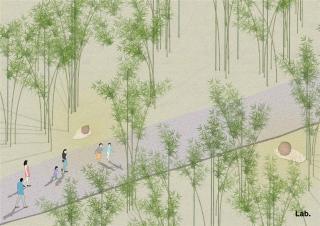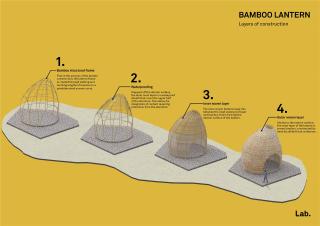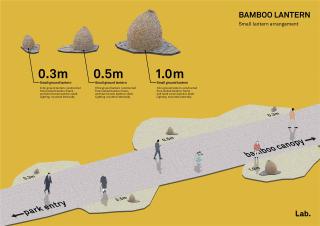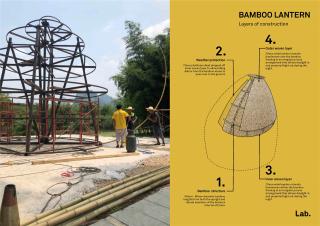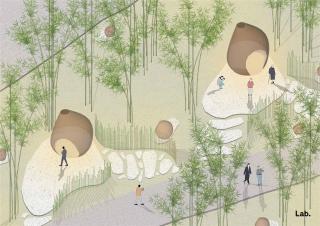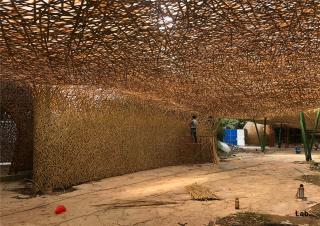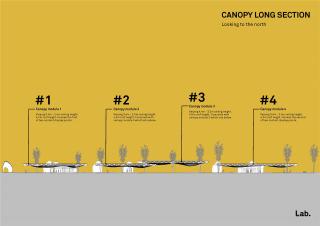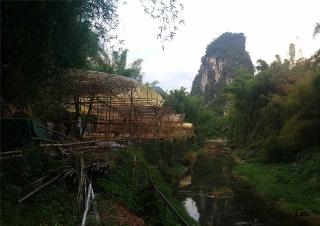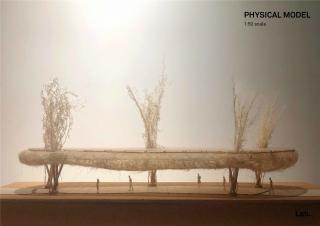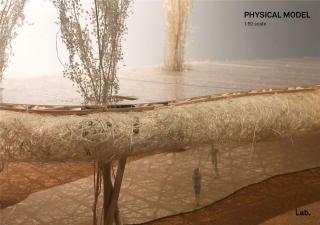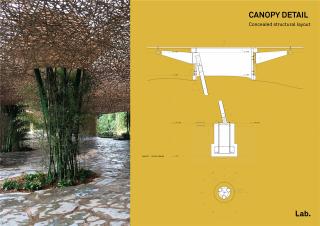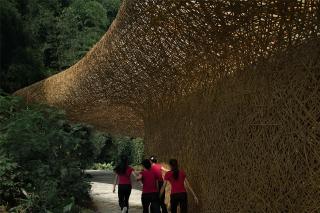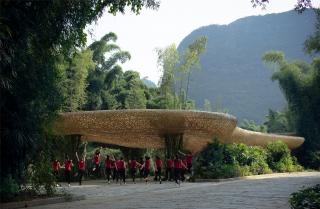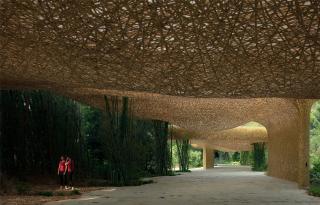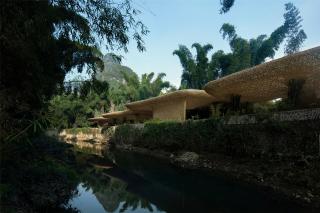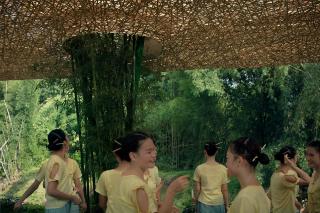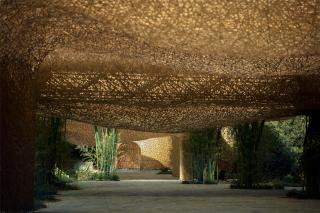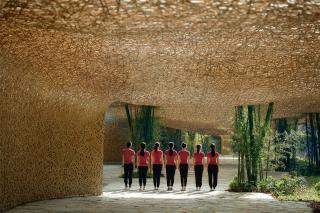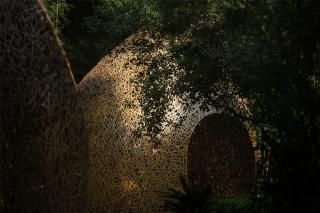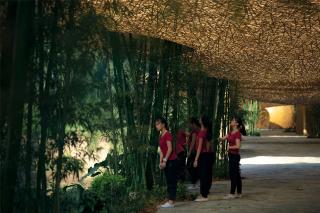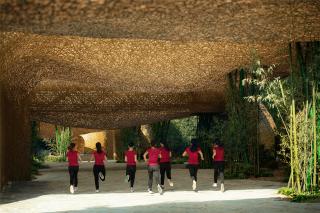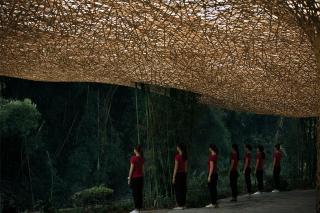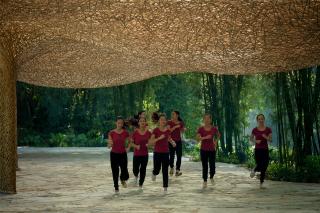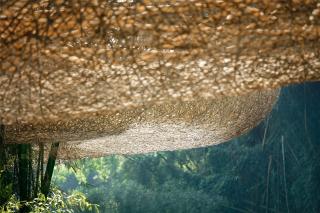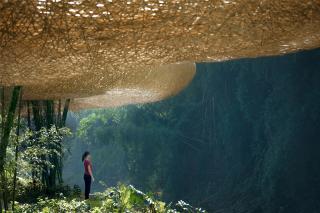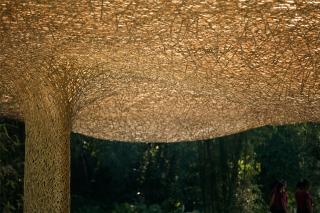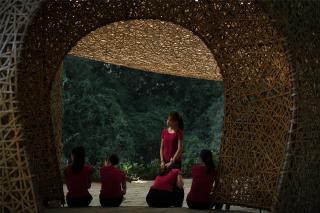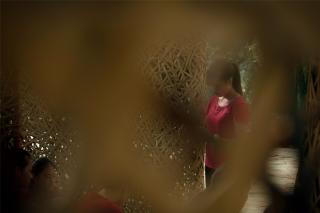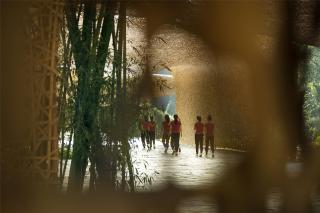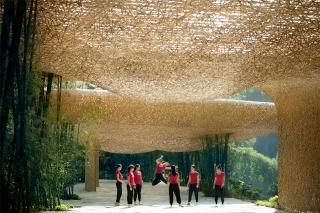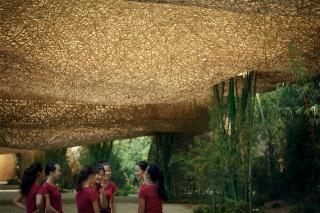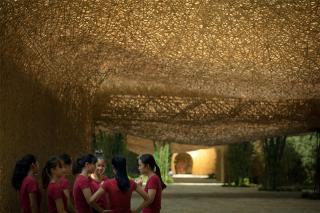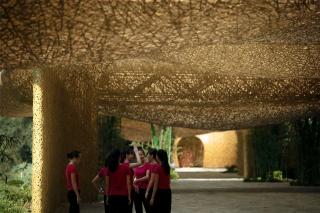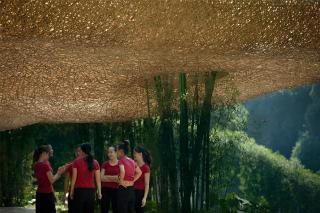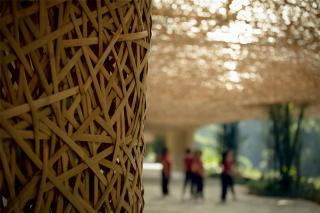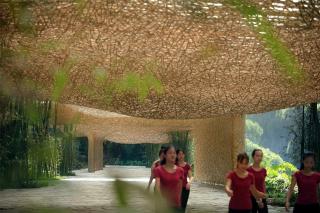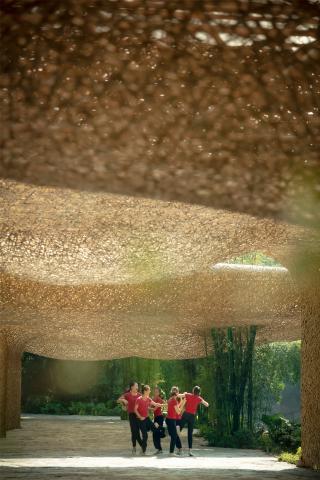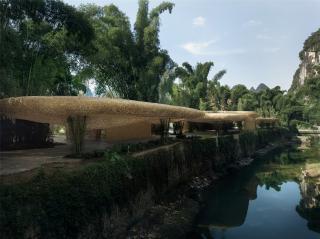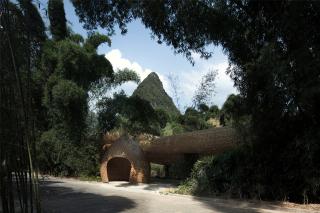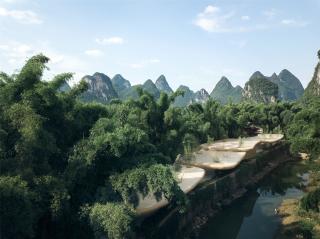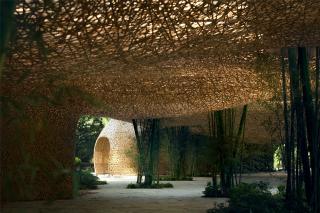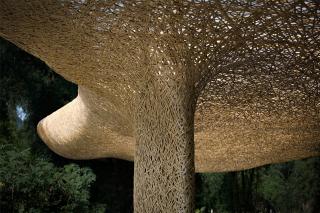桂林山水甲天下��,項(xiàng)目地位于陽(yáng)朔印象劉三姐園區(qū)��,中國(guó)最富戲劇性的自然景觀環(huán)境區(qū)之一。無(wú)盡的綠植環(huán)繞著大型山丘巨石之間��,面對(duì)如此宏偉的景觀地貌�,任何與之不協(xié)調(diào)而對(duì)抗的設(shè)計(jì)手法都變得不再合理�?�;谶@種對(duì)于現(xiàn)場(chǎng)的理解���,自然元素本身即成為這次建筑概念設(shè)計(jì)的前提�,尤其是竹子�。
The Impression Sanjie Liu, Yangshuo, Guilin is located in one of the most dramatic landscapes in China. Endless greenery surrounds the site filling space between large karst towers of rock. With a landscape so grand any moves to dismiss it, let alone compete would make little sense. With this understanding it was decided that the natural elements themselves would form the premise for what architecture would inhabit the site, one element in particular, bamboo.
▼項(xiàng)目鳥(niǎo)瞰
Aerial view the project ?存在建筑
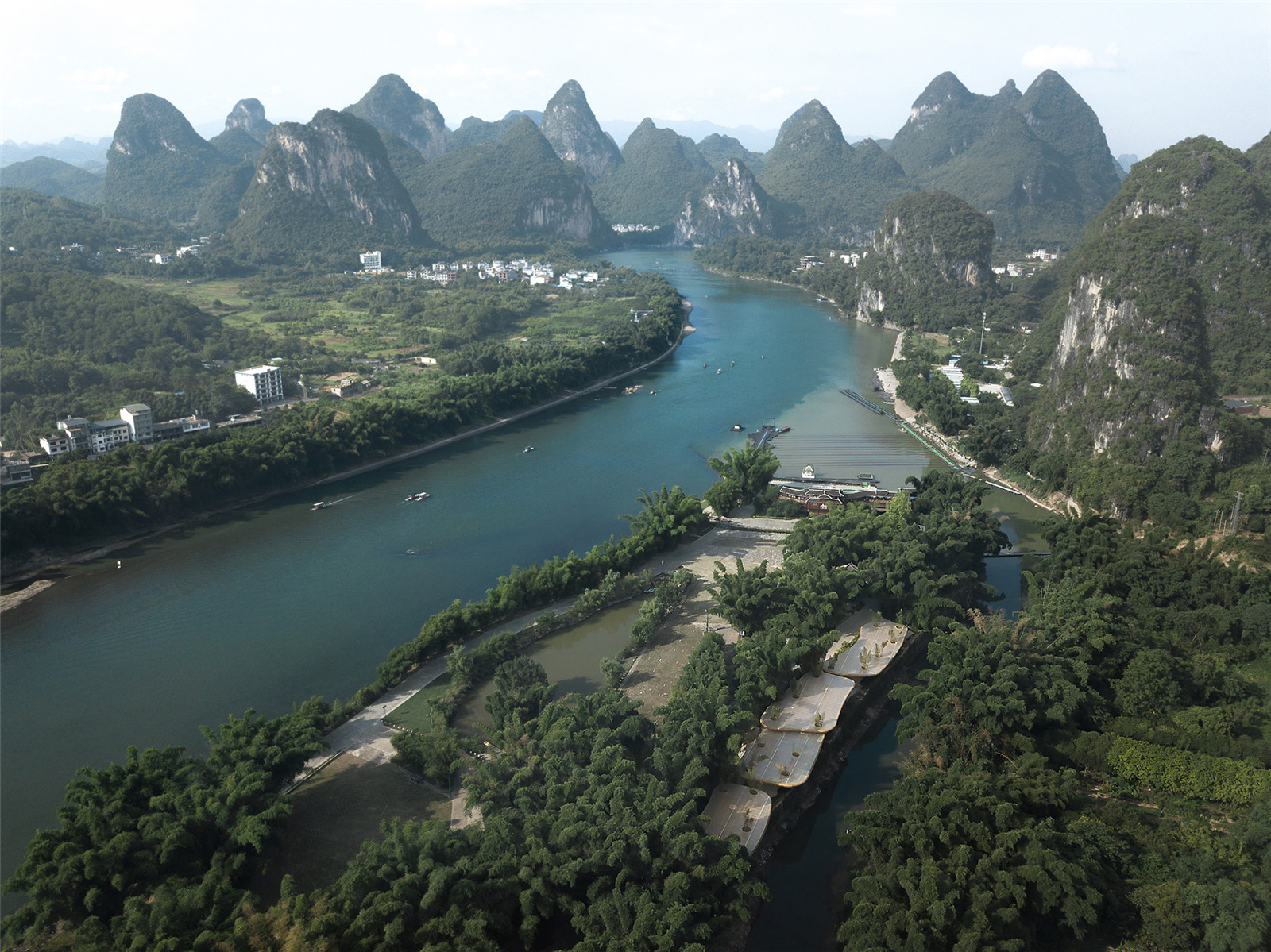
印象劉三姐園區(qū)的演出,已經(jīng)運(yùn)營(yíng)15年的時(shí)間了���。參考本地景觀的狀態(tài)����,針對(duì)于該項(xiàng)目的設(shè)計(jì)出發(fā)點(diǎn)提出了一種將大多數(shù)現(xiàn)有結(jié)構(gòu)維持不變的想法����,將設(shè)計(jì)和規(guī)劃的重點(diǎn)轉(zhuǎn)移到采用一種可以維護(hù)現(xiàn)有景觀的同時(shí),更加強(qiáng)調(diào)和突出本地自然之美的干預(yù)手法����。
The Impression Sanjie Liu is already well established, now in its 15th year of operation. The project presented a situation where most existing structures would remain untouched. Instead focus shifted to how introducing new intervention could support a pre-existing condition.
▼項(xiàng)目沿河外觀
External view of the project along the river ?存在建筑
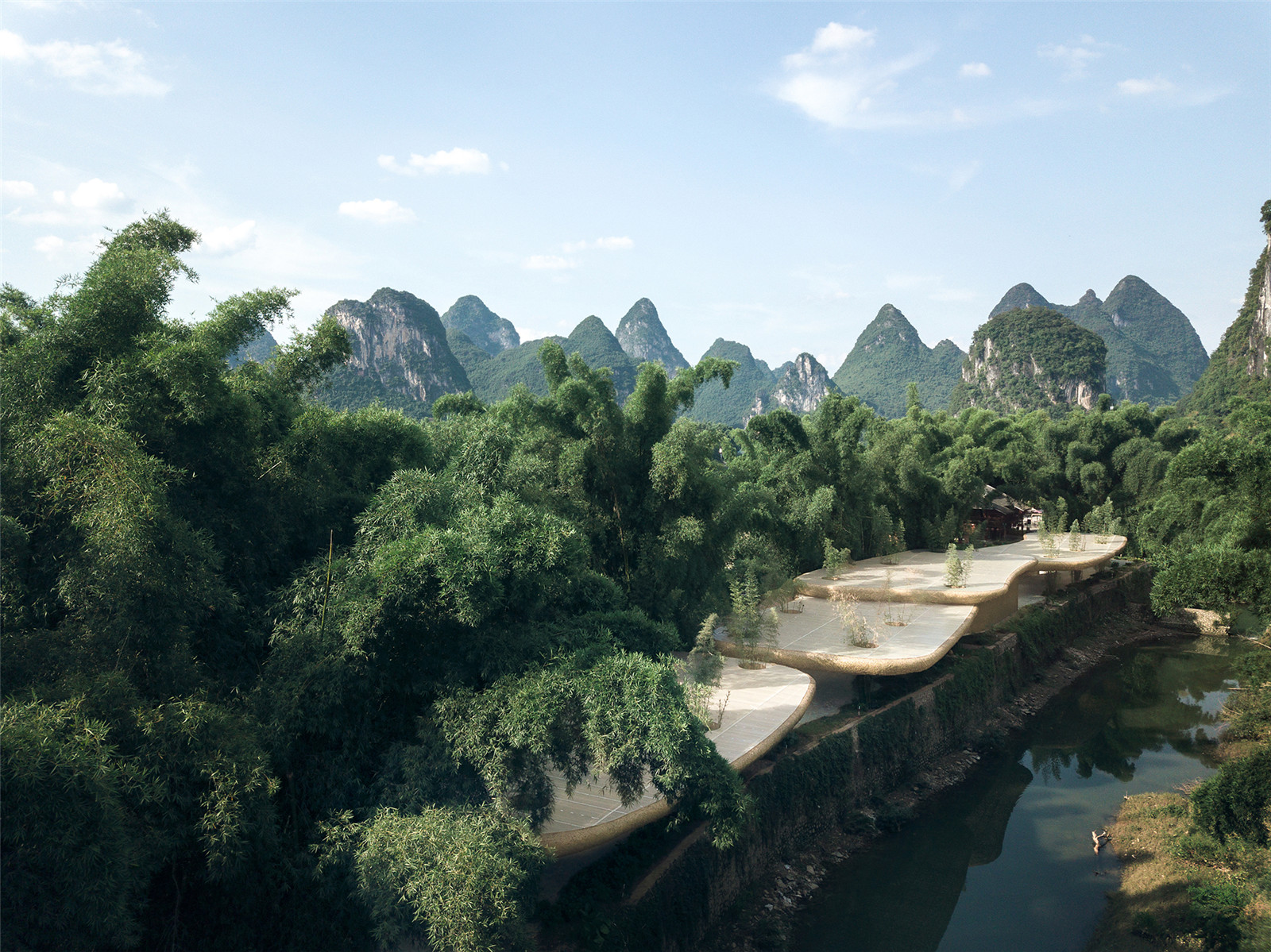
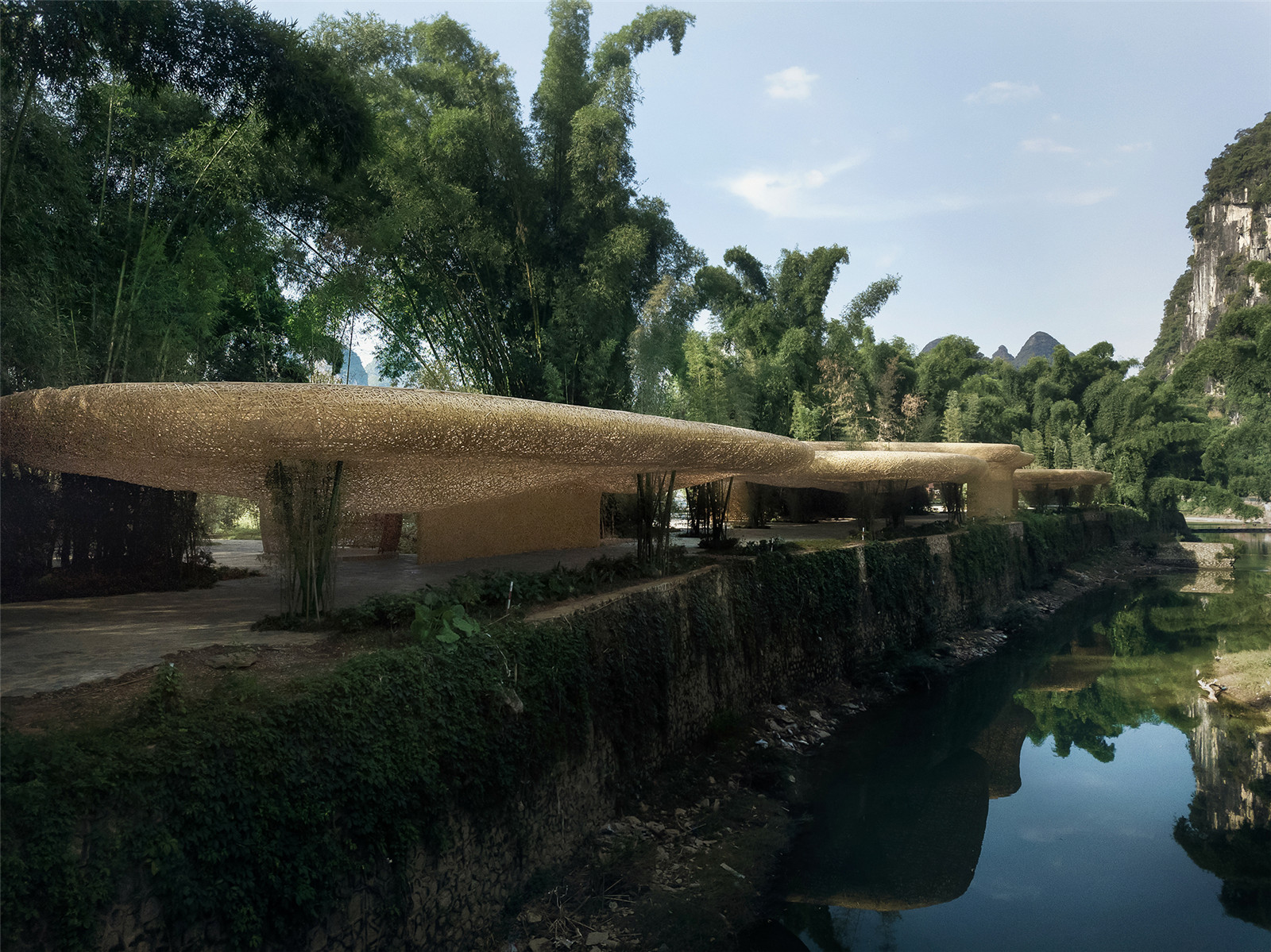
目前,大部分地區(qū)都覆蓋有大片竹子�,形成了竹林綠道長(zhǎng)廊的結(jié)構(gòu)。為了與已經(jīng)存在的方式相吻合�,新建筑考慮借用竹子的生長(zhǎng)習(xí)性和其生長(zhǎng)過(guò)程中形成的空間形態(tài)����,將其重新配置以形成新的空間�����。這樣的設(shè)計(jì)和實(shí)施策略���,使新形成的空間不會(huì)與現(xiàn)有的自然環(huán)境相互競(jìng)爭(zhēng),同時(shí)卻有呼應(yīng)和強(qiáng)化的效果�。盡管自然的手法,達(dá)到最佳效果需要過(guò)度時(shí)期和相對(duì)來(lái)說(shuō)較長(zhǎng)的時(shí)間�����,但這樣的過(guò)程反而更能體現(xiàn)出這樣可生長(zhǎng)的設(shè)計(jì)策略的力量�,同時(shí)增強(qiáng)了感受者與周?chē)闹窳趾颓鹆甑幕?dòng)感和意識(shí)感。
At present, large clusters of bamboo cover most of the site, creating structures of mingling pipes and leaves. As a means to coincide with what is already there, the new architecture looked at borrowing the materiality of the bamboo, reconfiguring it to form new space. In doing so, this new space means not to contest. Instead it aims to augment, albeit very gently, the surrounding bamboo groves and hills.
▼新的空間與自然環(huán)境相融合
The new space merges with the natural environment ?存在建筑
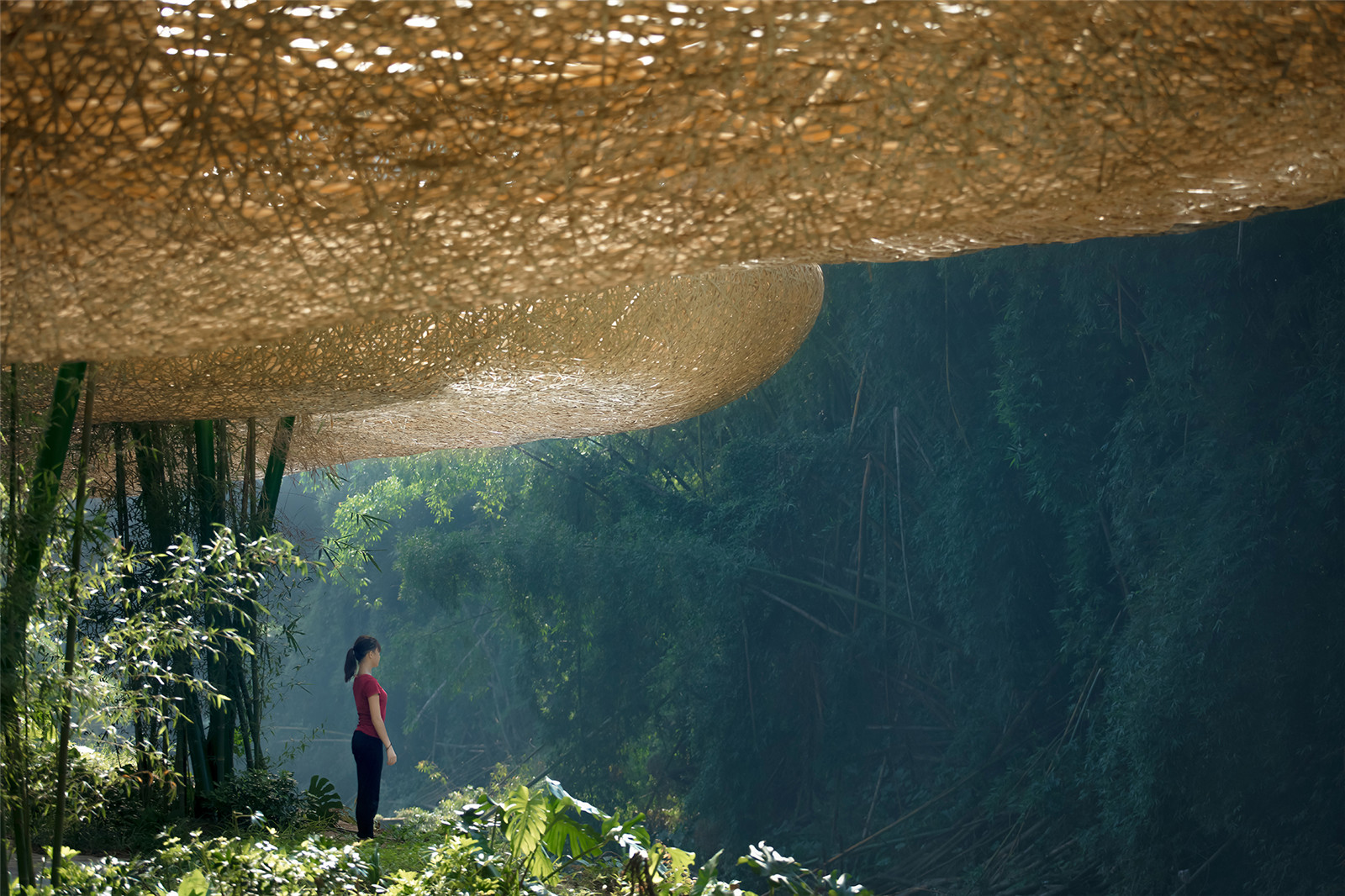
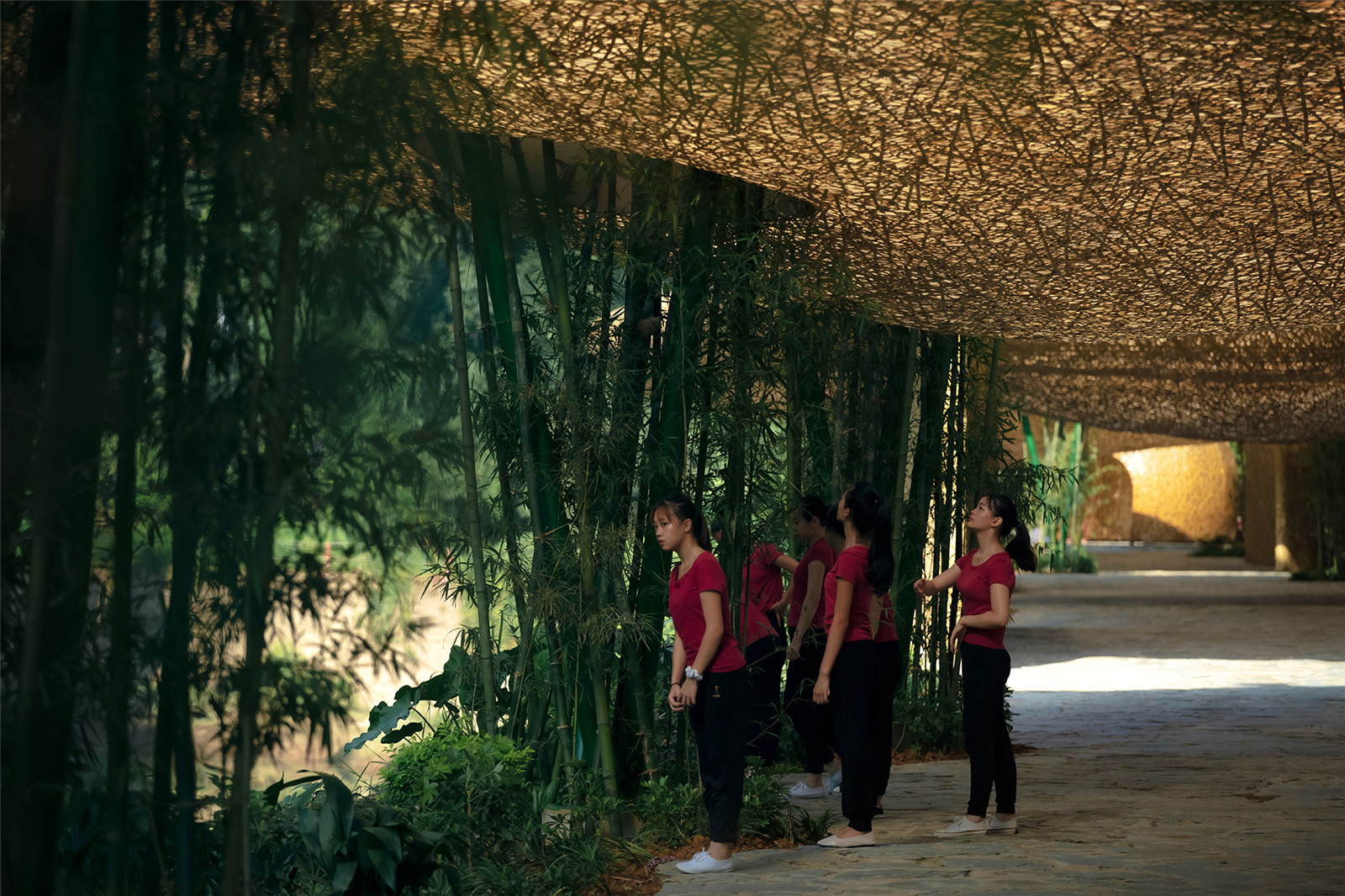
印象劉三姐的演出在天黑后開(kāi)始���,觀眾和園區(qū)的拜訪者主要集中在園區(qū)島嶼的兩端�,起始點(diǎn)為園區(qū)的主入口���,即賓客到達(dá)的入口和原鼓樓區(qū)域(現(xiàn)修繕后的印象劉三姐文化博物館場(chǎng)地)�����,另一端��,也就是演出舞臺(tái)及觀眾席�����,則位于園區(qū)最深處的漓江岸邊��。而此兩端之間�,占據(jù)園區(qū)大部分區(qū)域的空間卻僅僅作為交通疏散及流線的區(qū)域來(lái)使用,完全沒(méi)有連接性的文化內(nèi)容幫助訪客獲得更有意義的體驗(yàn)��。正是在這個(gè)中間模棱兩可的空間里����,項(xiàng)目的概念引入了兩個(gè)新的體系以融合入現(xiàn)有的自然肌理同時(shí)形成一種情緒感知及故事文化的鋪墊過(guò)程。
Currently, the night show entertains guests in two areas, one at either end of the island site. The entry and pagoda where guests arrive, and the main stage, perched at the bank of the Li river at the other end. Between these two points little interaction takes place. It is here in this middle ground that two new assemblies of architecture are introduced.
▼連接園區(qū)島嶼兩端的空間
Space connecting both ends of the island in the park ?存在建筑
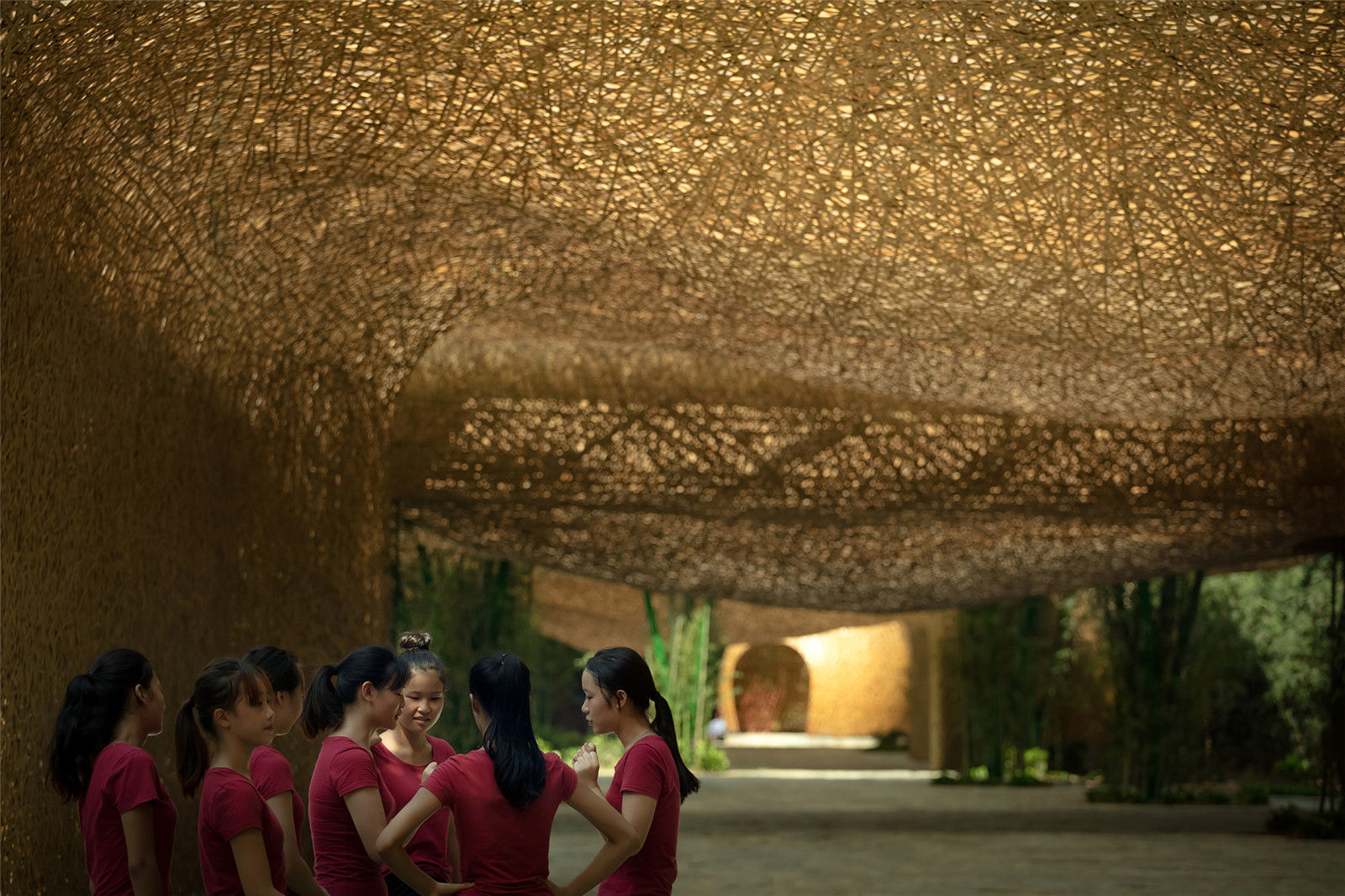
第一個(gè)體系“竹燈未央”, 即手工竹編制成的燈籠結(jié)構(gòu)空間���,散落分布在訪客入場(chǎng)流線的區(qū)域�,以作為入場(chǎng)前感受印象劉三姐文化的體驗(yàn)/文創(chuàng)銷(xiāo)售/休憩空間點(diǎn)��。另一個(gè)體系“手工竹藝長(zhǎng)廊”, 在竹叢之間形成一層手工編織高低錯(cuò)落的“竹網(wǎng)”,提供了可以避開(kāi)常規(guī)降雨的步行區(qū)域���。這兩個(gè)竹體體系的創(chuàng)建和形成��,則不僅僅是作為它們本身存在的屬性�,而它們與周?chē)匀画h(huán)境的材料上的�,肢體上的,感受上的一種內(nèi)外在的共鳴與呼應(yīng)�,則更是不斷傳遞著層層更新的意義,使相互賦予更強(qiáng)更有活力的生命力���。
The first, woven bamboo lantern structures, scattered where guests circulate, whose purpose is to guide and intrigue. Then the other, a stretch of woven canopy amongst clusters of bamboo, providing area to walk sheltered from regular rainfall. In these, the architecture relies on bamboo not only for its composition, but also its constant referral to parts that constitutes the place.
▼“竹燈”設(shè)計(jì)圖紙及施工
Bamboo lantern design drawings and construction ?llLab. 敘向建筑設(shè)計(jì)
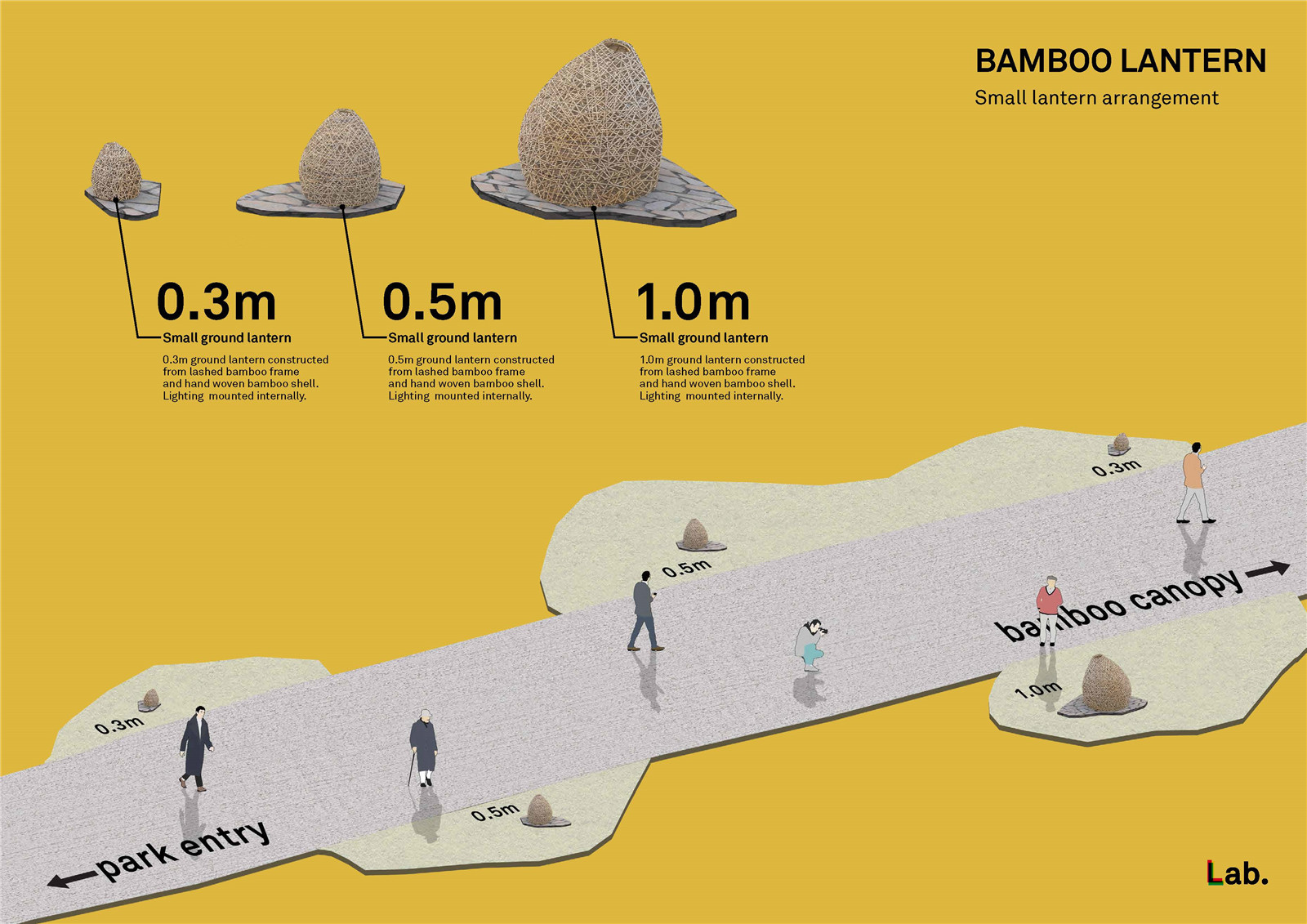
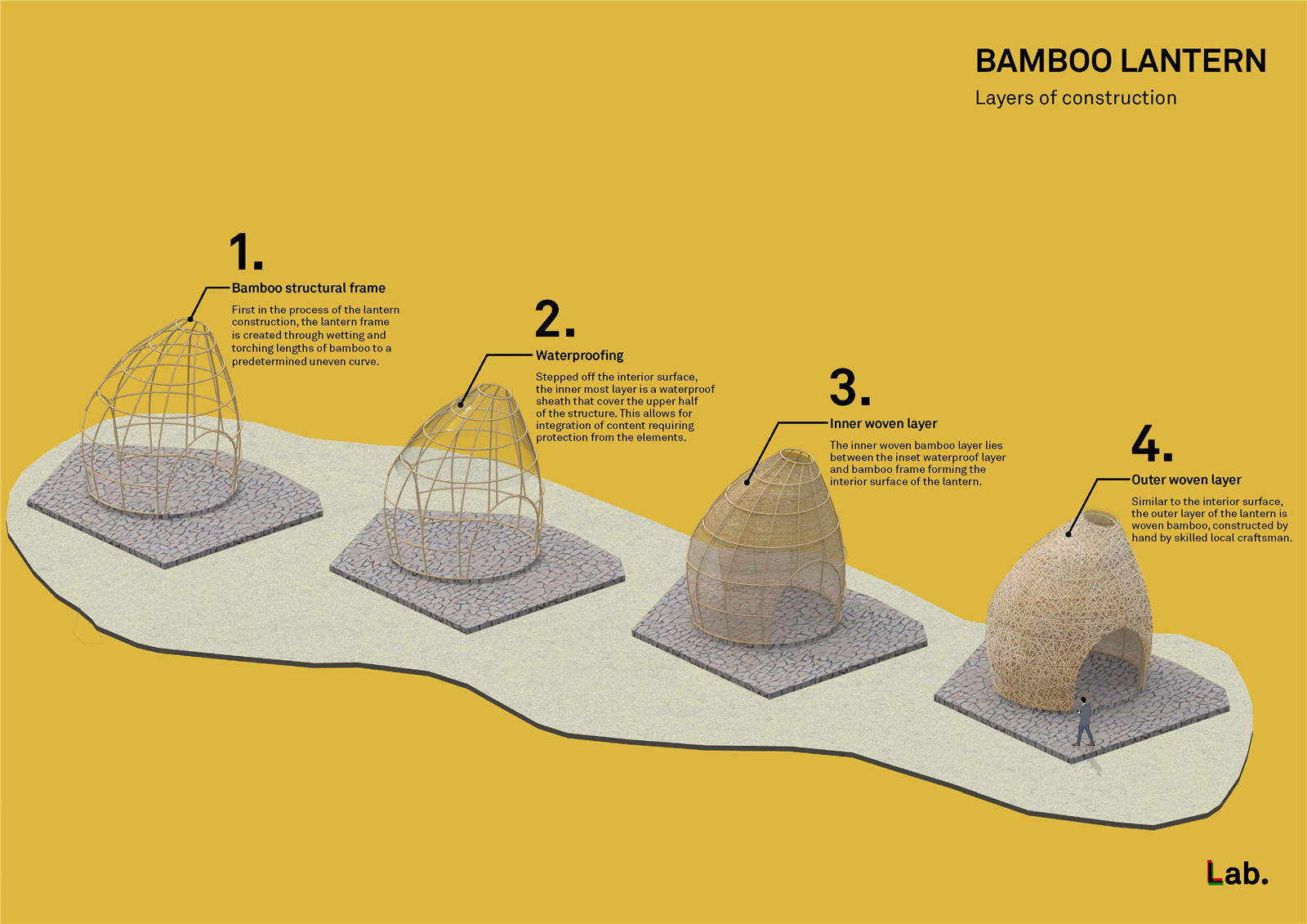
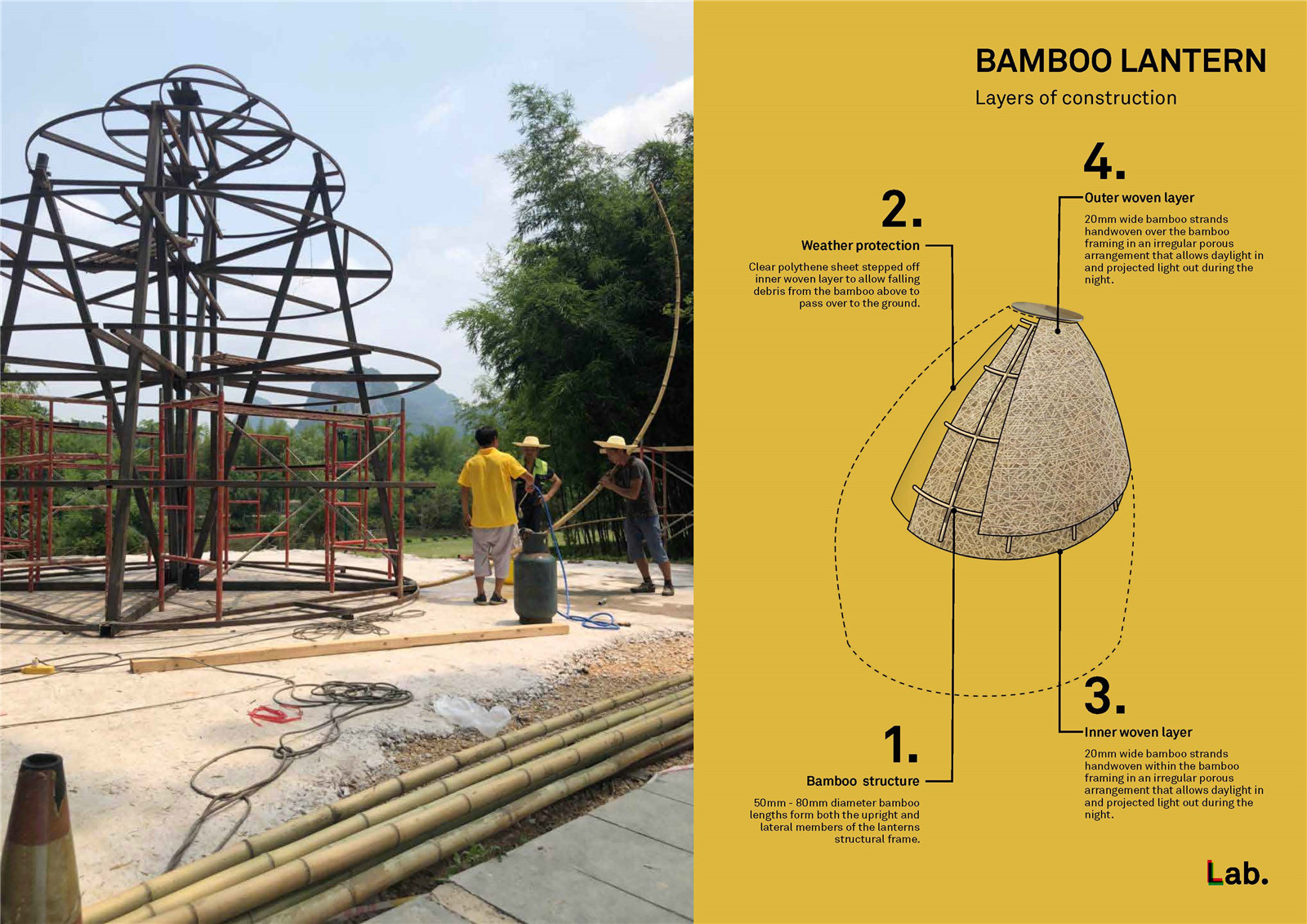
▼手工竹編制成的燈籠結(jié)構(gòu)空間“竹燈未央”
Woven bamboo lantern structures ?存在建筑
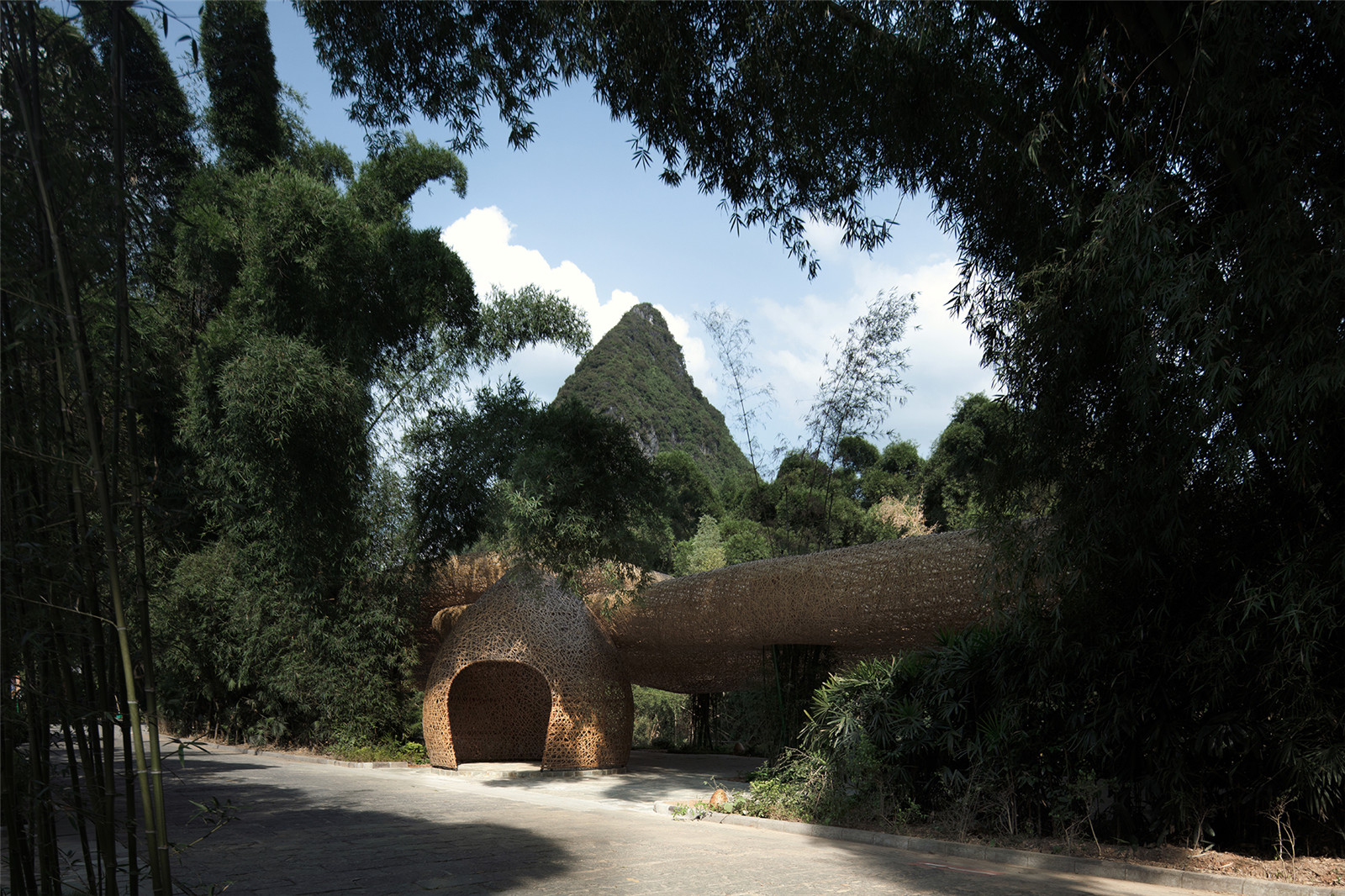
▼手工竹藝長(zhǎng)廊設(shè)計(jì)圖紙及施工
Woven canopy design drawings and construction ?llLab. 敘向建筑設(shè)計(jì)
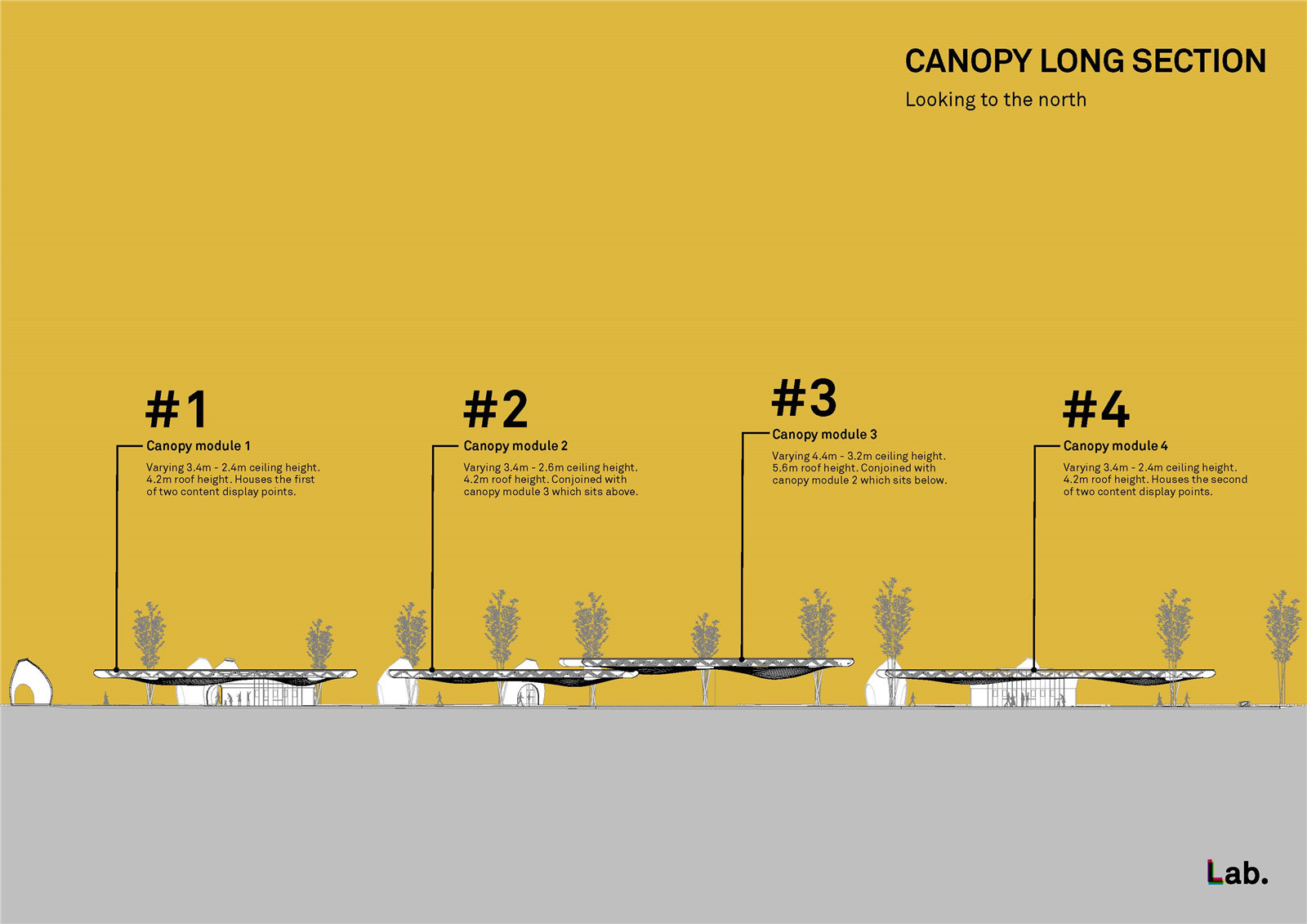
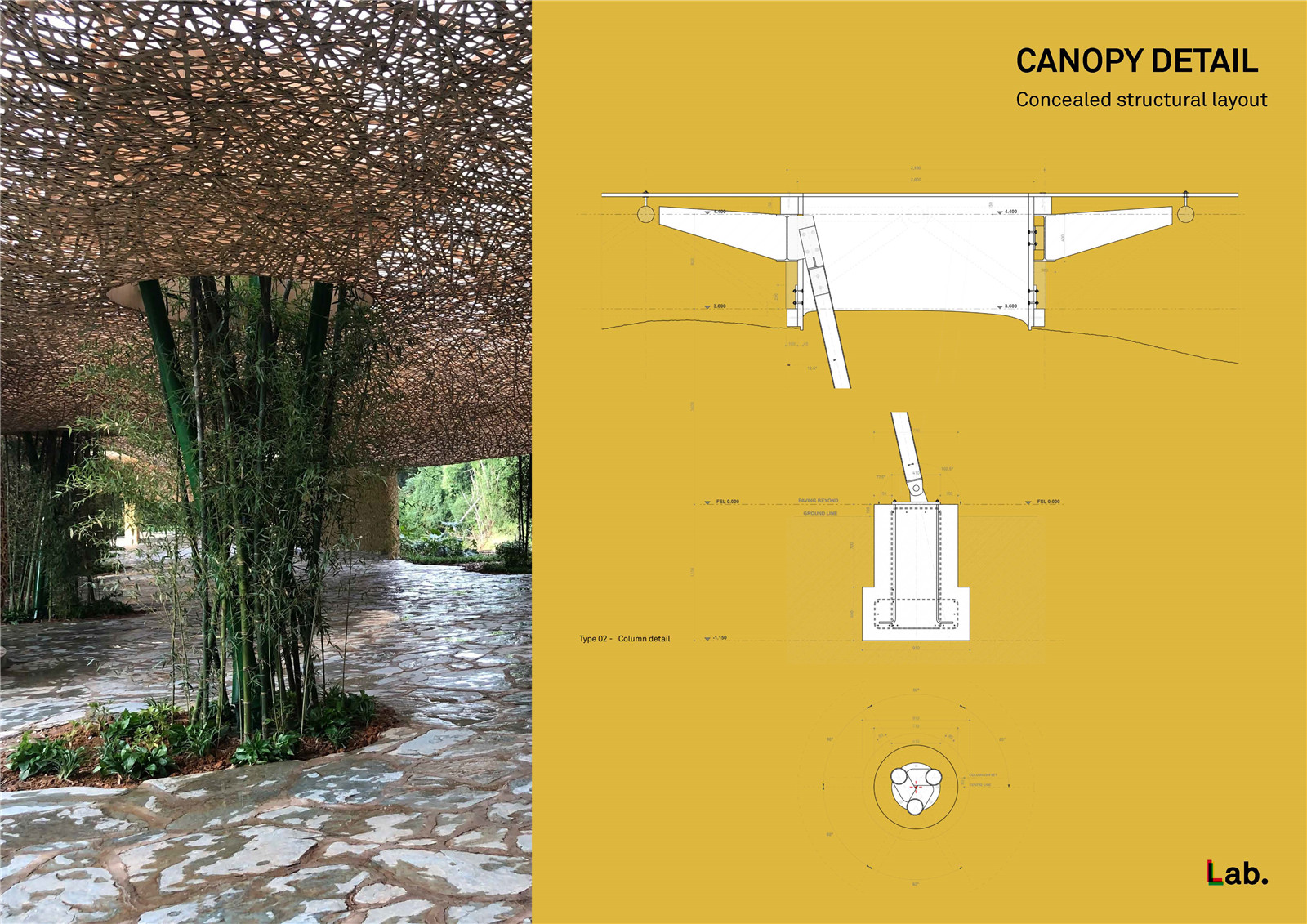
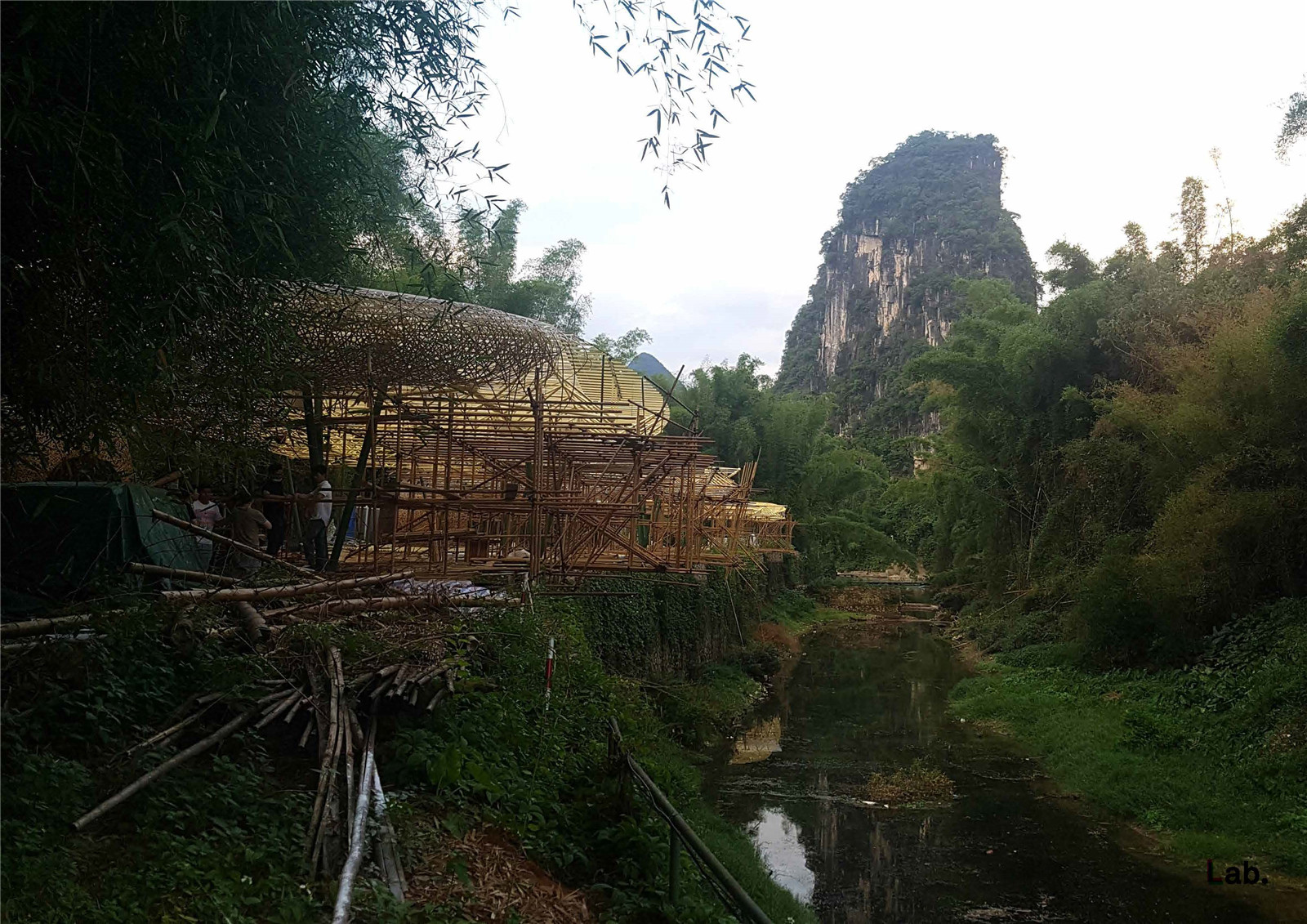
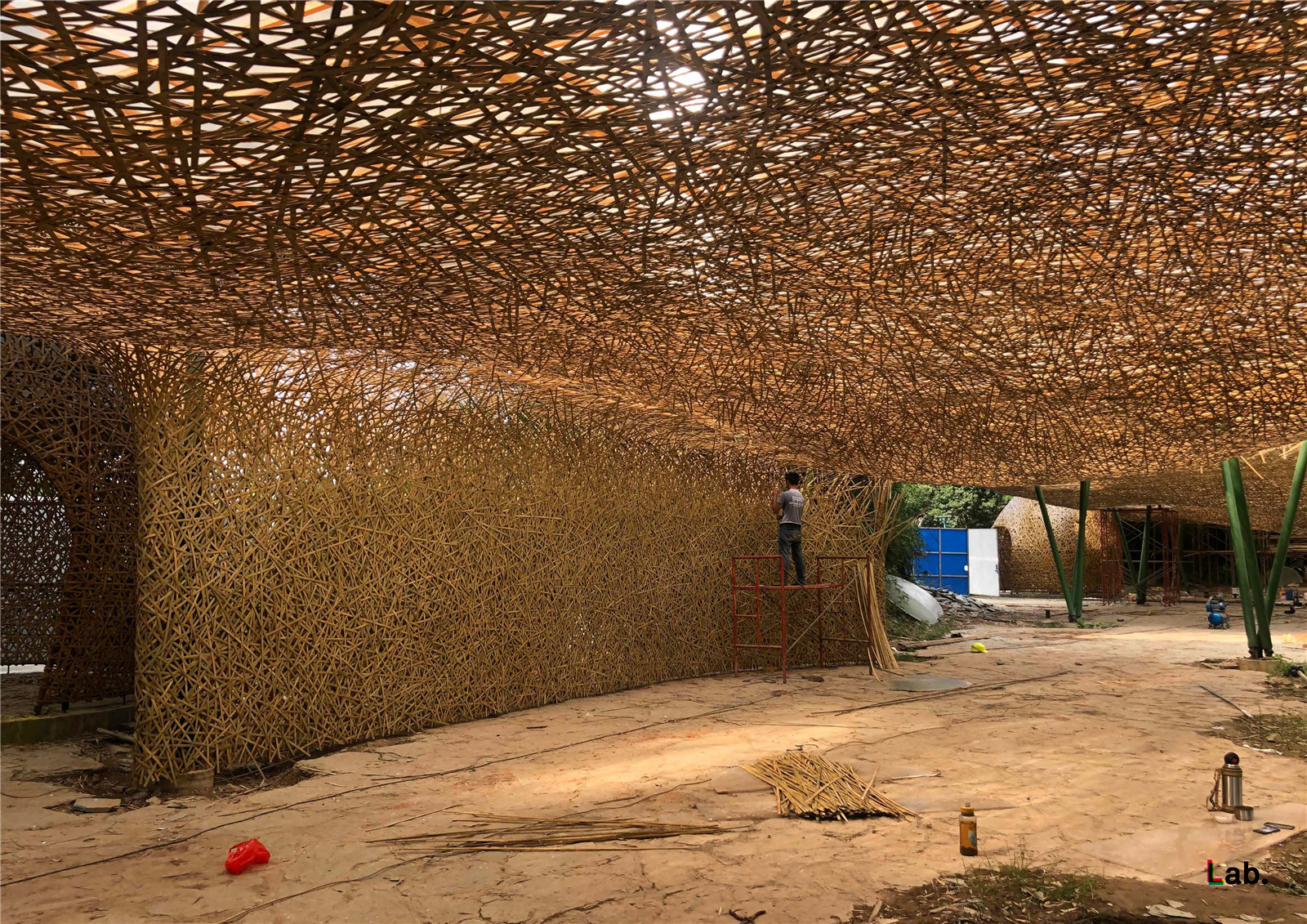
▼“手工竹藝長(zhǎng)廊”在竹叢之間形成一層手工編織高低錯(cuò)落的“竹網(wǎng)”
A stretch of woven canopy amongst clusters of bamboo ?存在建筑
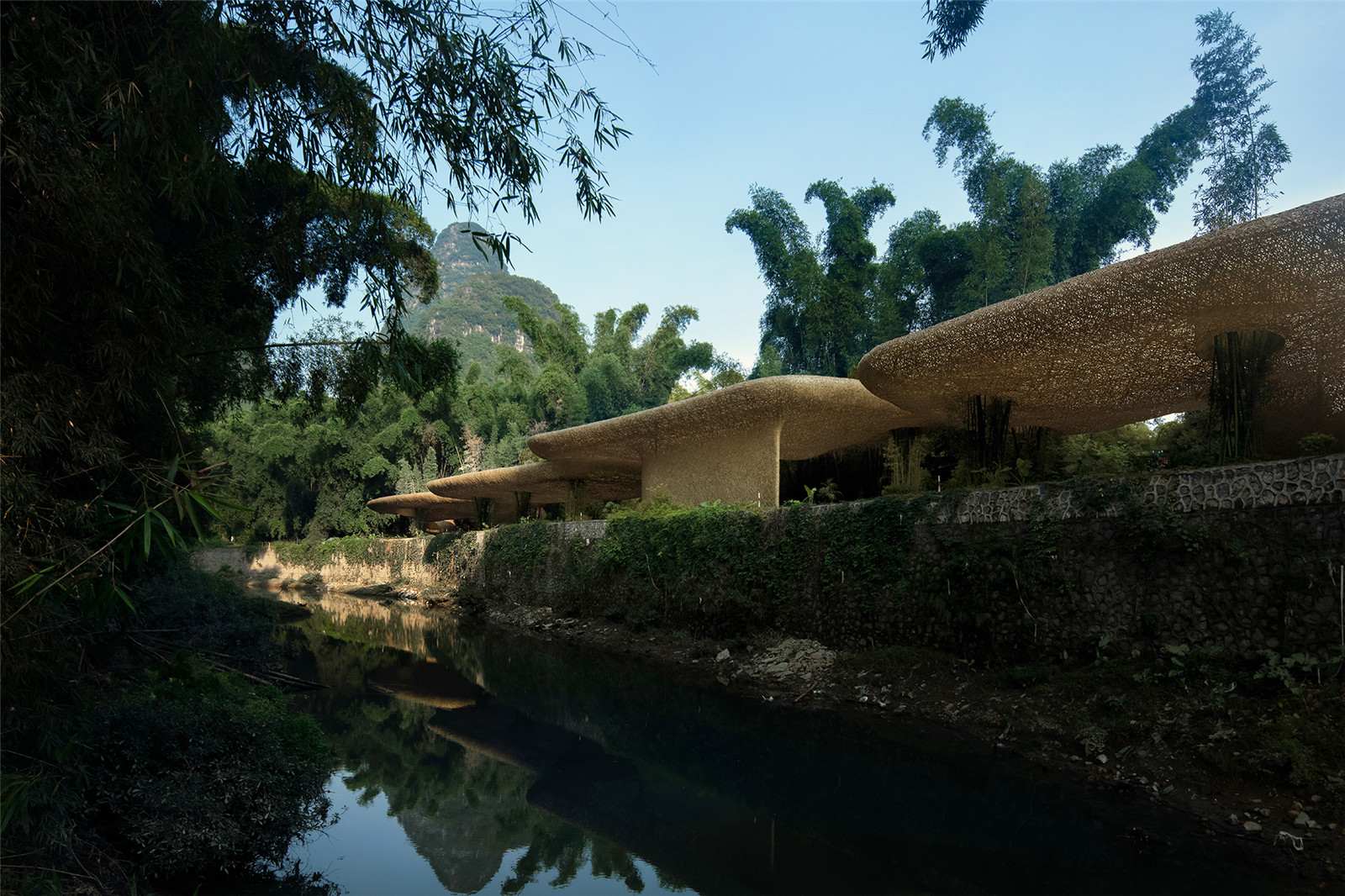
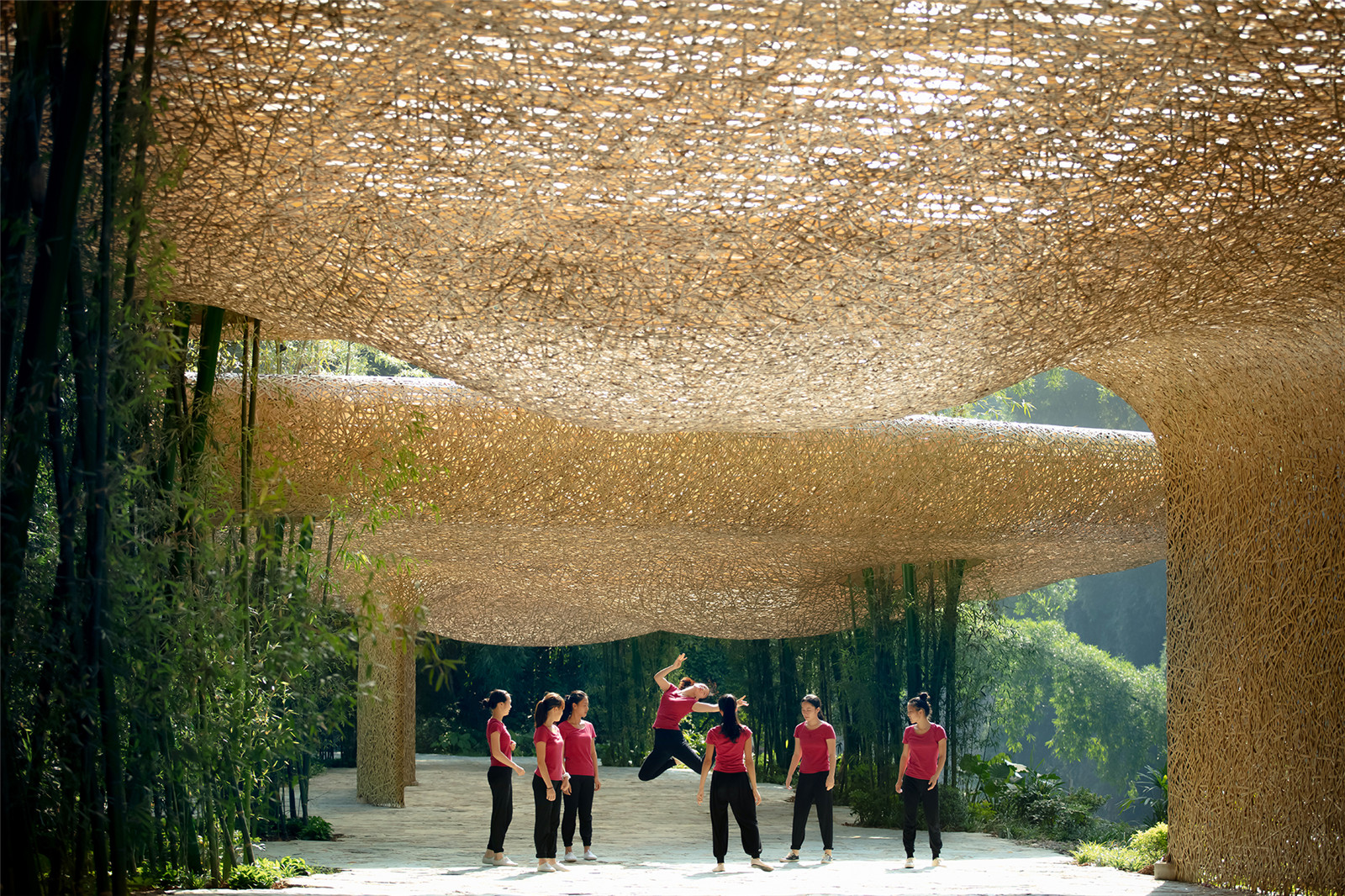
▼從長(zhǎng)廊看向竹燈
View to the lantern from the canopy ?存在建筑
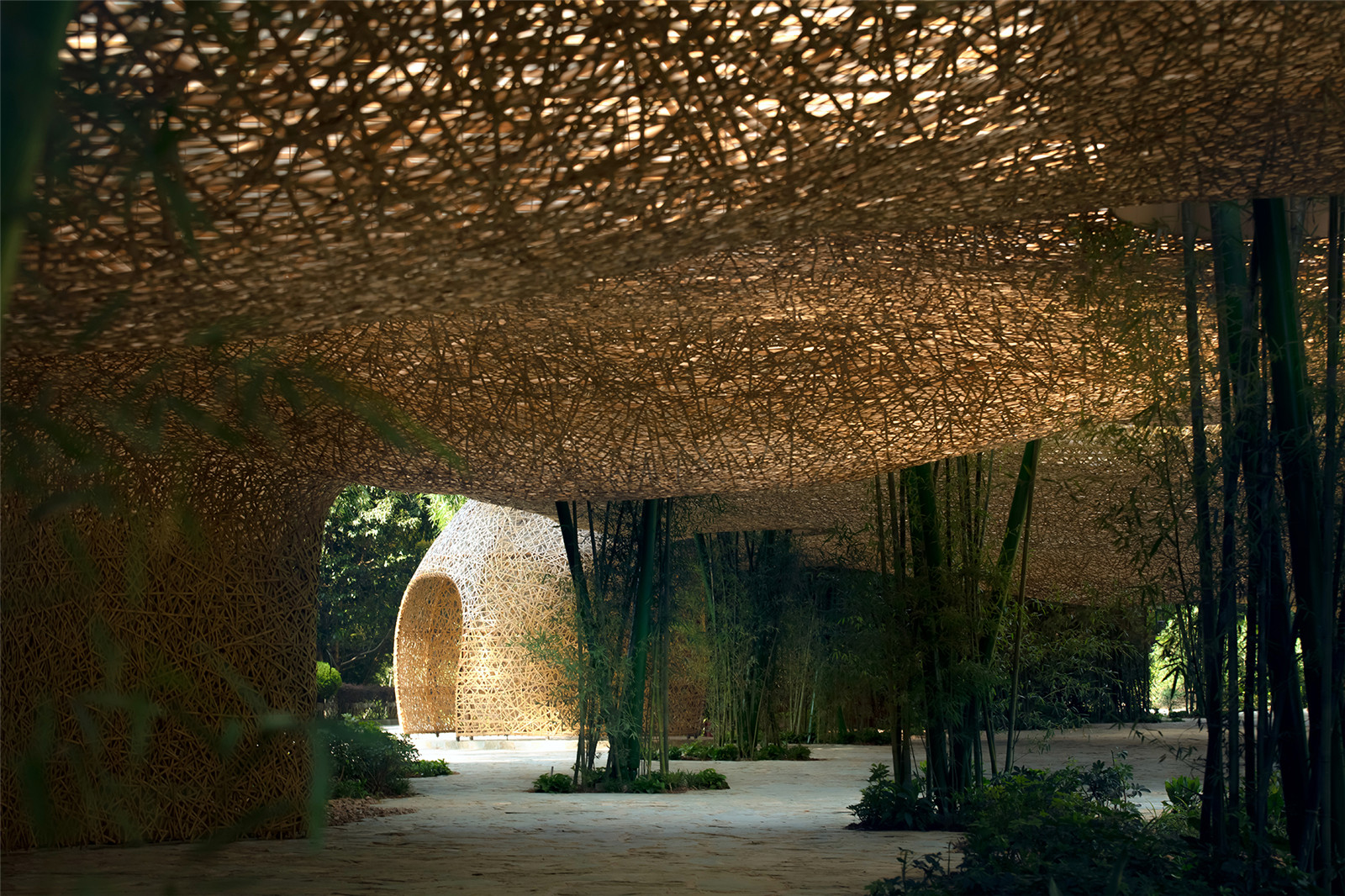
剛剛進(jìn)入園區(qū)時(shí),沿著通往演出場(chǎng)地的通道��,體型較小的竹燈會(huì)發(fā)出斑駁的光線信號(hào)�,隨著訪客進(jìn)一步向園區(qū)深處走去時(shí),原本視覺(jué)上因?yàn)榫嚯x而感覺(jué)是竹燈的體量突然變得越來(lái)越大����,以至于可以成為可以供人使用的空間。視覺(jué)產(chǎn)生的體積大小的錯(cuò)覺(jué)���,和當(dāng)認(rèn)知到這個(gè)實(shí)現(xiàn)錯(cuò)覺(jué)并感受到不同體量變化帶來(lái)的物品和空間的不同感受時(shí)��,原本純流線的行走通道則因此變得有趣���,從而不再因?yàn)楣δ苌虾托袨樯系膯我恍詭?lái)感受上的單調(diào)感�����。
When entering the site, lanterns small in stature line along the pathway cast out signals of dappled light. As visitors travel further the once small lanterns become drastically larger to a point where the guests can find themselves able to walk inside. The makeup of the lanterns remains sincere, with a structure of bamboo lengths encased in lashed bamboo either side.
▼從小到大的竹燈引導(dǎo)人進(jìn)入
Bamboo lanterns from small to large leading people to the entrance ?llLab. 敘向建筑設(shè)計(jì)

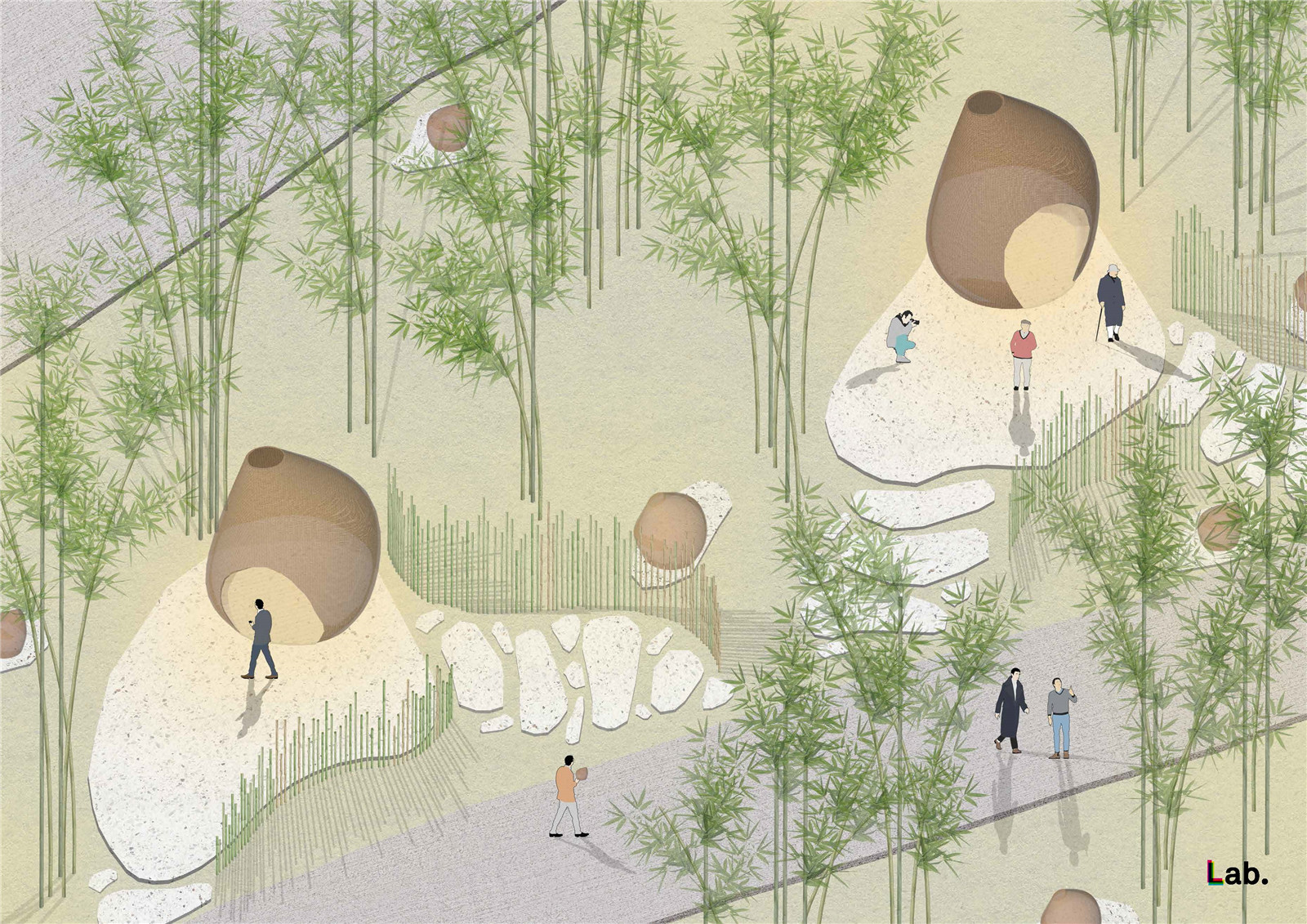
竹燈的妝容是真誠(chéng)的�����,內(nèi)外兩側(cè)都由手工切割的竹條綁扎包裹著天然竹桿自然找形形成的竹制結(jié)構(gòu)����。微觀視角地觀察其細(xì)節(jié)����,人們可以感覺(jué)到只有在真正手工制作的條件下才能創(chuàng)造出的隨機(jī)美感。竹燈的外側(cè)編織層感官上略顯深暗一些�����,即真實(shí)反映了通過(guò)火燒加熱處理以形成彎曲的竹燈輪廓所留下的自然印跡�����。基于此工藝的基礎(chǔ)上���,當(dāng)?shù)氐墓そ硤F(tuán)隊(duì)以隨機(jī)的方式將無(wú)數(shù)的竹條相互穿插纏繞�����,不夾雜任何膠水或釘子來(lái)保持其形狀和紋理�,并完全自然地以此方式尋找著最真實(shí)的光線穿透效果���。這種生產(chǎn)方法展示了錯(cuò)綜復(fù)雜卻最合理真實(shí)的創(chuàng)造方式��,同時(shí)清晰地由工匠們的手及其潛意識(shí)對(duì)材料的深刻理解和對(duì)材料美感的意識(shí)形態(tài)所塑造�。
On closer inspection one can get a sense of the random beauty that can only be created when something is truly constructed by hand. The slightly dark appearance of bamboo framing shows markings of how it is bowed with fire to create the curved lantern silhouette. Over this, piece by piece, teams of local craftsman have threaded numerous stripes of bamboo in an unintentional pattern that requires no glues or nails to hold its shape. This method of production is a showcase of intricacy, clearly shaped by the hands of people and their intuition of beauty.
▼竹燈細(xì)部����,自然編織
Details of the lantern composed of stripes of bamboo in an unintentional pattern ?存在建筑
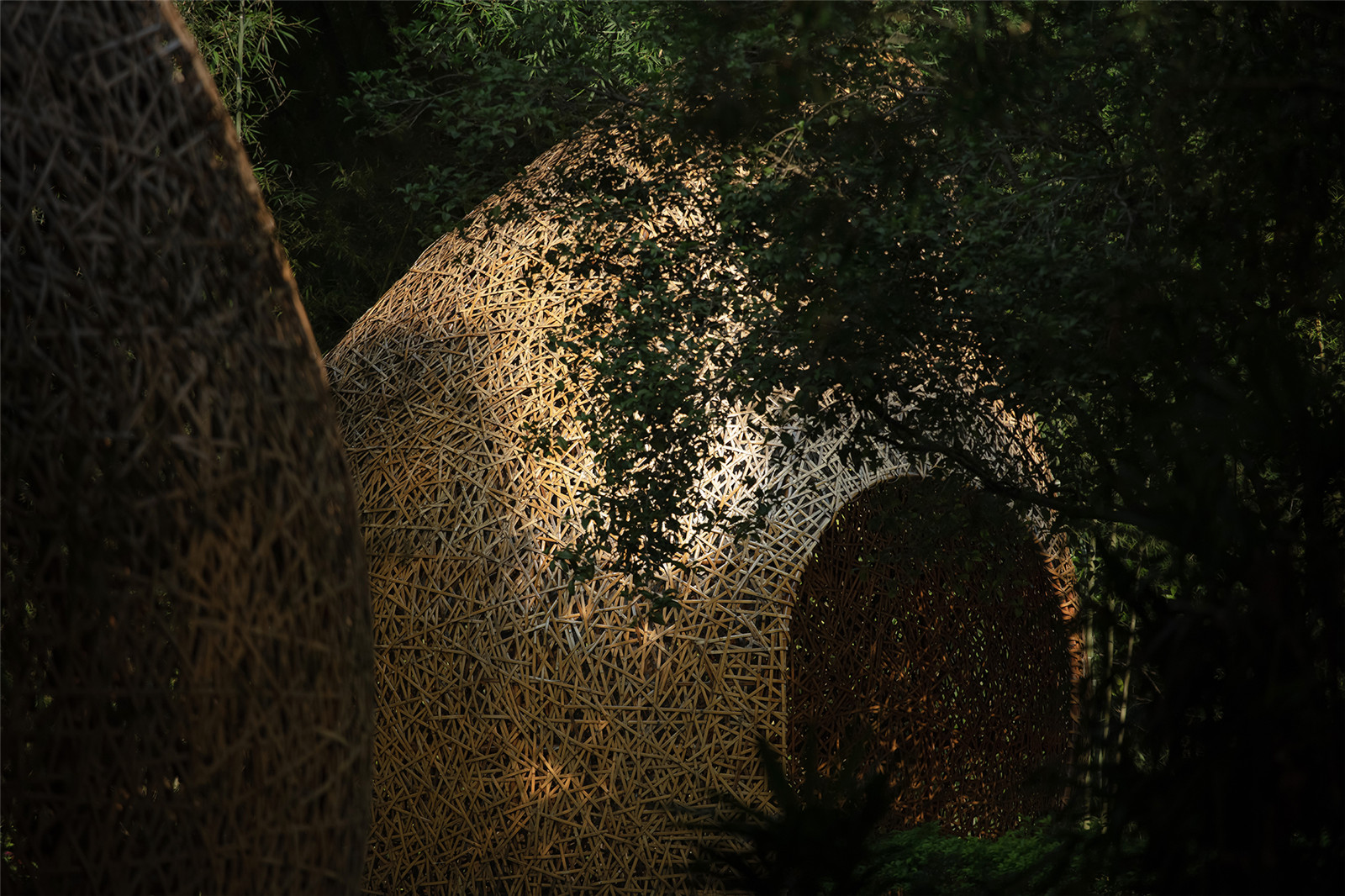
在日光下���,竹燈的外形顯得相對(duì)堅(jiān)實(shí)�����,外殼的黃色與綠色的環(huán)境相輔相成��。到了晚上�����,竹燈的個(gè)性從空間性的體態(tài)轉(zhuǎn)變?yōu)槎嗫锥油ㄍ傅男问?�。竹燈本身成為光的散射體����,與訪客一起玩起了視覺(jué)空間的變形和光線變化的戲劇游戲。從整體上看��,竹燈的概念取之于園區(qū)竹叢在空中交錯(cuò)而形成的拱形門(mén)洞式形態(tài)���,然而�,幾乎是一種偶然����,當(dāng)仰望遠(yuǎn)處時(shí),陽(yáng)朔的自然石山也呼應(yīng)了竹燈的輪廓�。桂林的風(fēng)景沿著眼前的地平線散落。
In the daylight, the lanterns appear solid, the yellow of the shell in compliment with the green surrounding. Come night the personality of the lantern shifts from something more unyielding to a porous shell. The lantern itself is a diffuser of light, playing theatrics of scale and light with guests. As a whole, the lantern looks at home under the arching towers of bamboo in its peripheries. Almost by chance, when looking to the distance the lantern silhouette is echoed by the stone towers of the Yangshuo, Guilin landscape strewn along the immediate horizon.
▼日光下竹燈外殼的黃色與綠色的環(huán)境相輔相成
The yellow of the shell in compliment with the green surrounding ?存在建筑
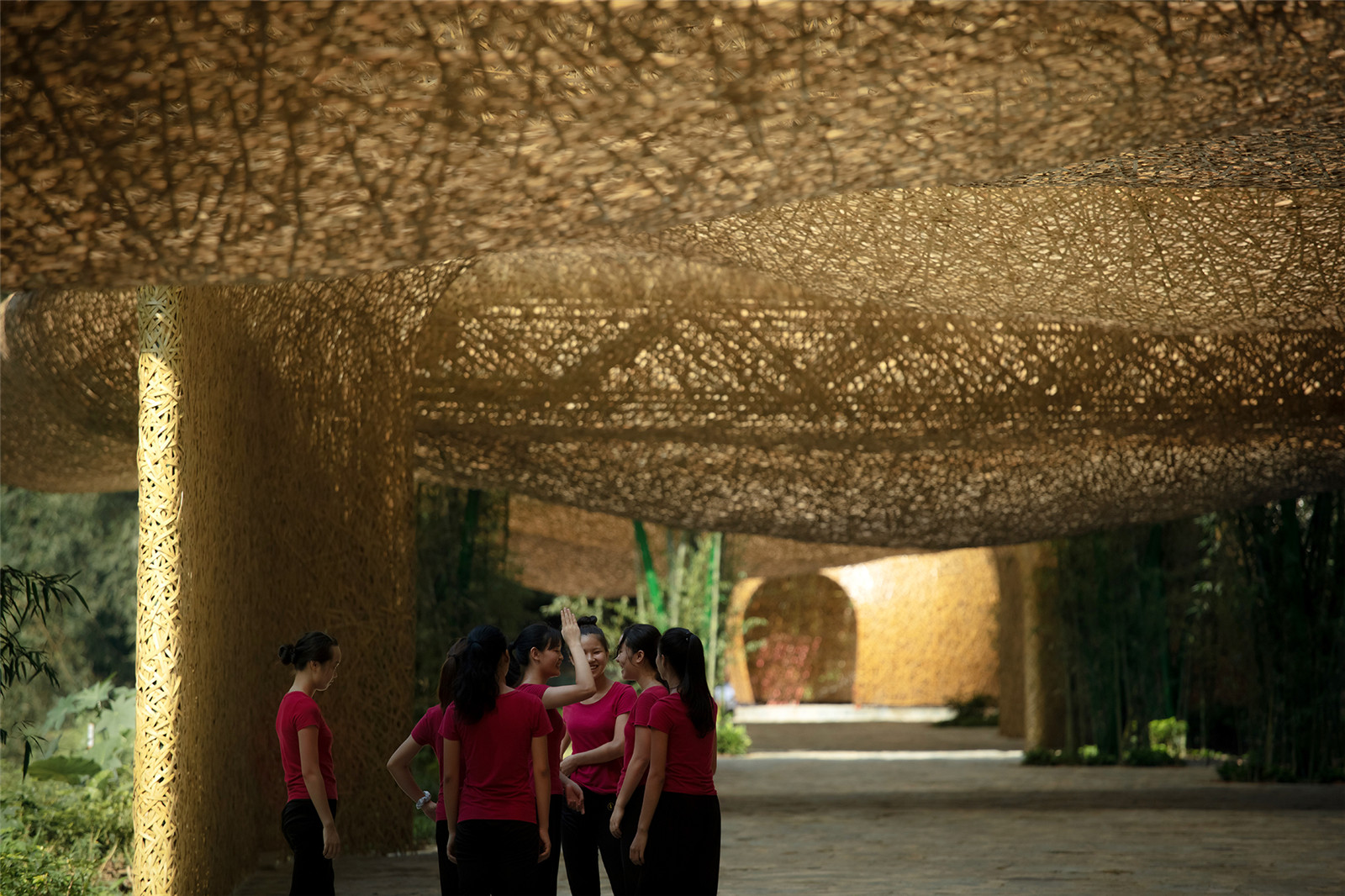
沿著島的邊緣伸展���,“手工竹藝長(zhǎng)廊”的竹棚飄浮在錯(cuò)落而至的竹叢之間����,乍一看,它似乎幾乎沒(méi)有依靠結(jié)構(gòu)支撐���,只有竹叢穿過(guò)竹棚圓形的開(kāi)口空間并向上生長(zhǎng)����,而隱藏在其中的如竹子般粗細(xì)的結(jié)構(gòu)柱���,則從其立足點(diǎn)開(kāi)始向上向外旋轉(zhuǎn)而扭曲地����,如模仿了竹子的生長(zhǎng)模式一般�,也長(zhǎng)入圓形的開(kāi)口空間并與竹棚內(nèi)部的結(jié)構(gòu)相連。
Further along at the edge of the island, the canopy shrouds itself within the large masts of bamboo. At first glance it appears to rely on little for support, only the columns of bamboo shooting up and through circular openings. Hidden amongst these living clusters columns twist from their footing upward and outward mimicking the indecisive route of the bamboo to meet the structure above. Supported by the columns in a maze of tubes, the structure of the canopy while seen doesn’t look out of place. The hand-woven layer obscures what is in front and what lays behind.
▼竹棚飄浮在錯(cuò)落而至的竹叢之間��,向遠(yuǎn)處延伸
The stretched canopy shrouds itself within the large masts of bamboo ?存在建筑
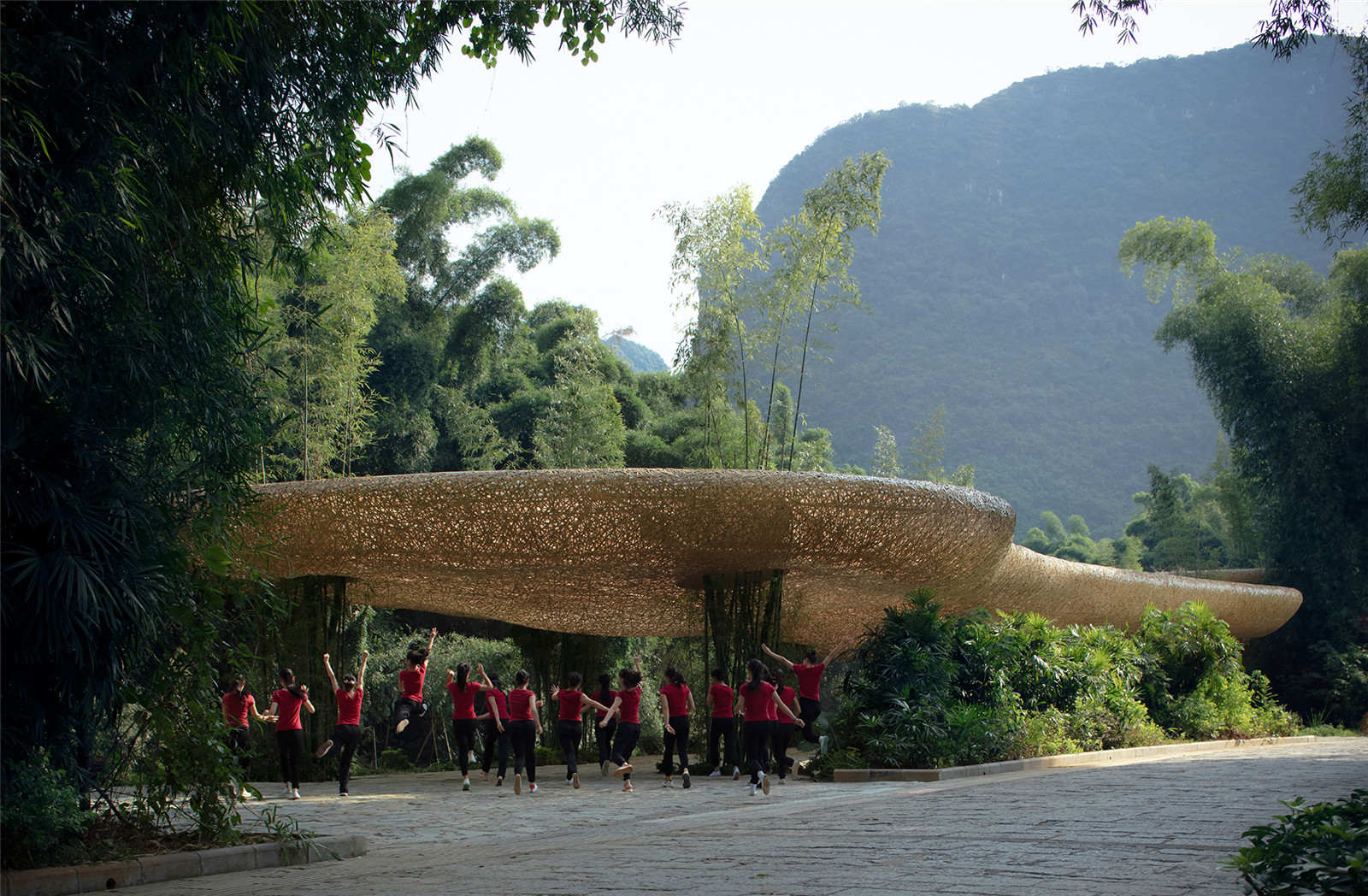
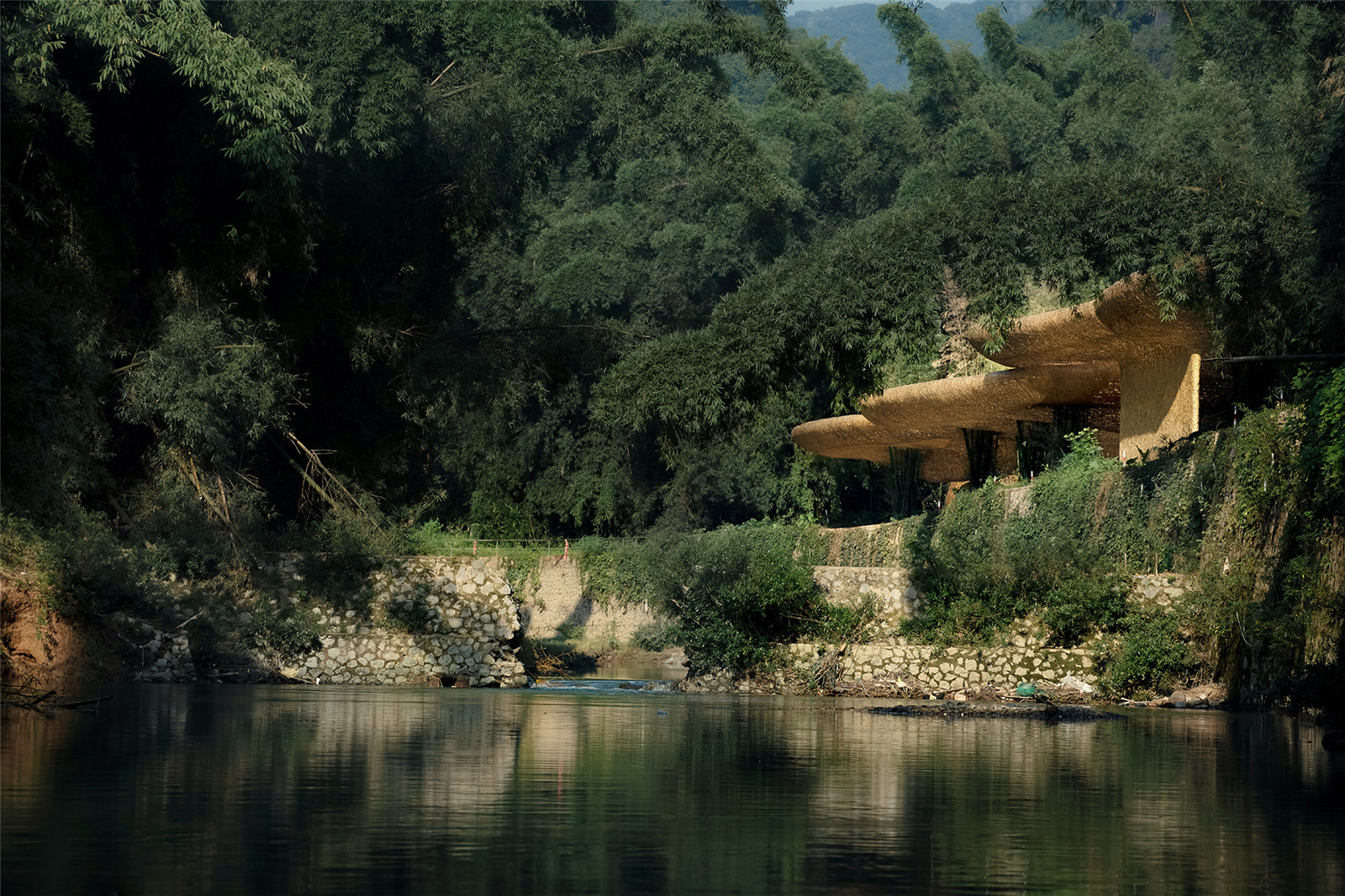
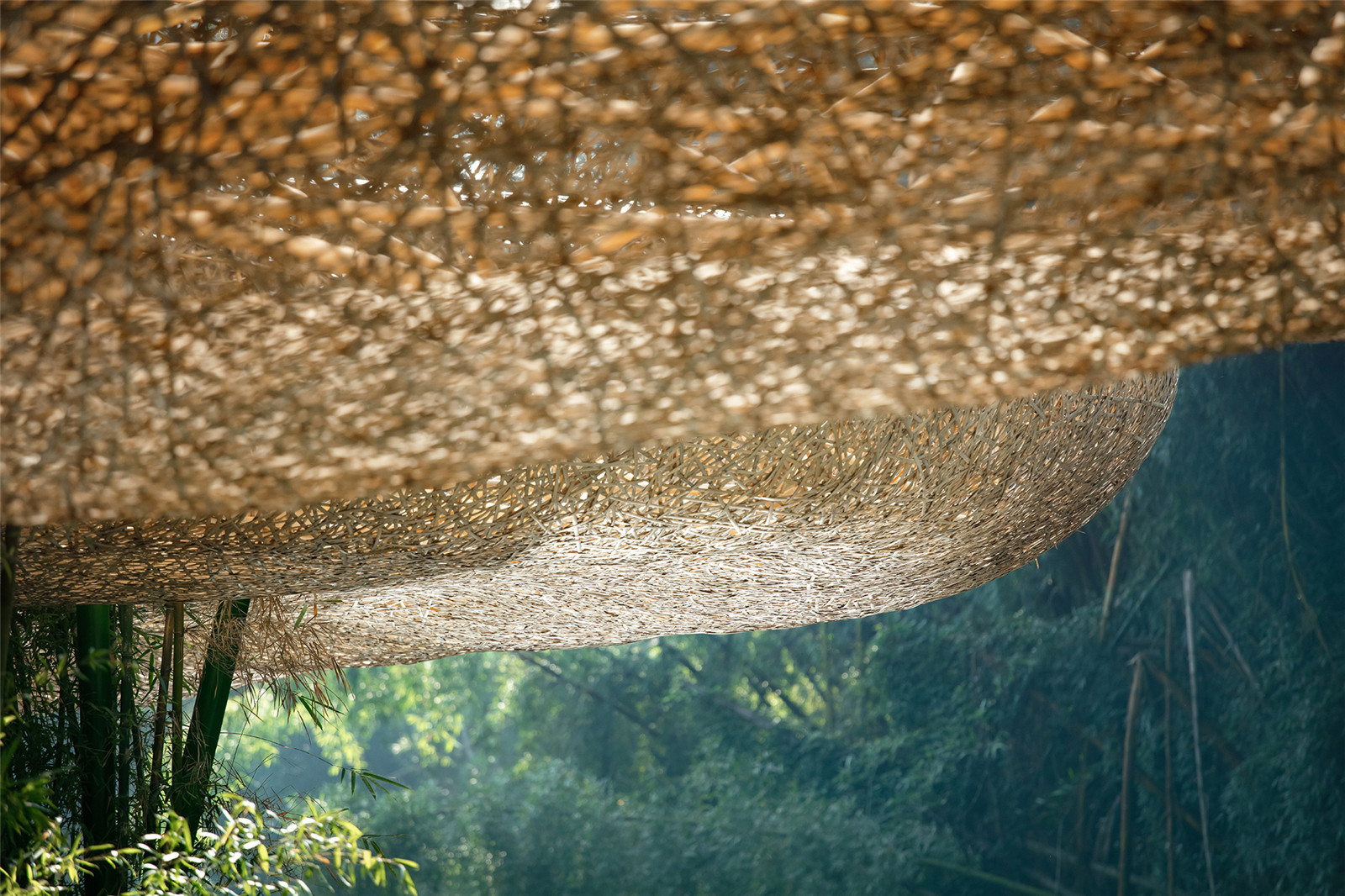
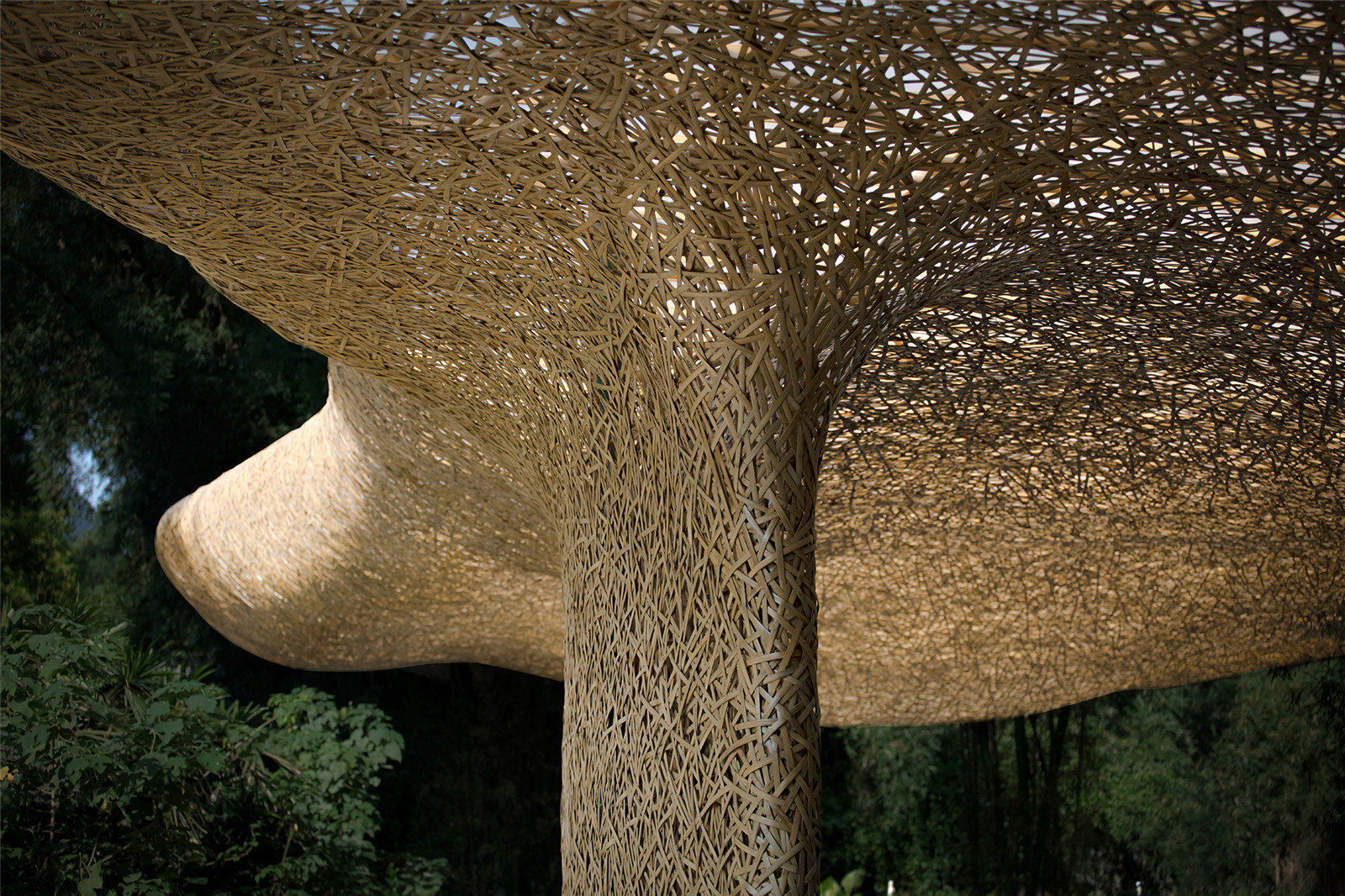
▼長(zhǎng)廊下仿佛沒(méi)有結(jié)構(gòu)支撐
There as if no vertical supporting under the canopy ?存在建筑
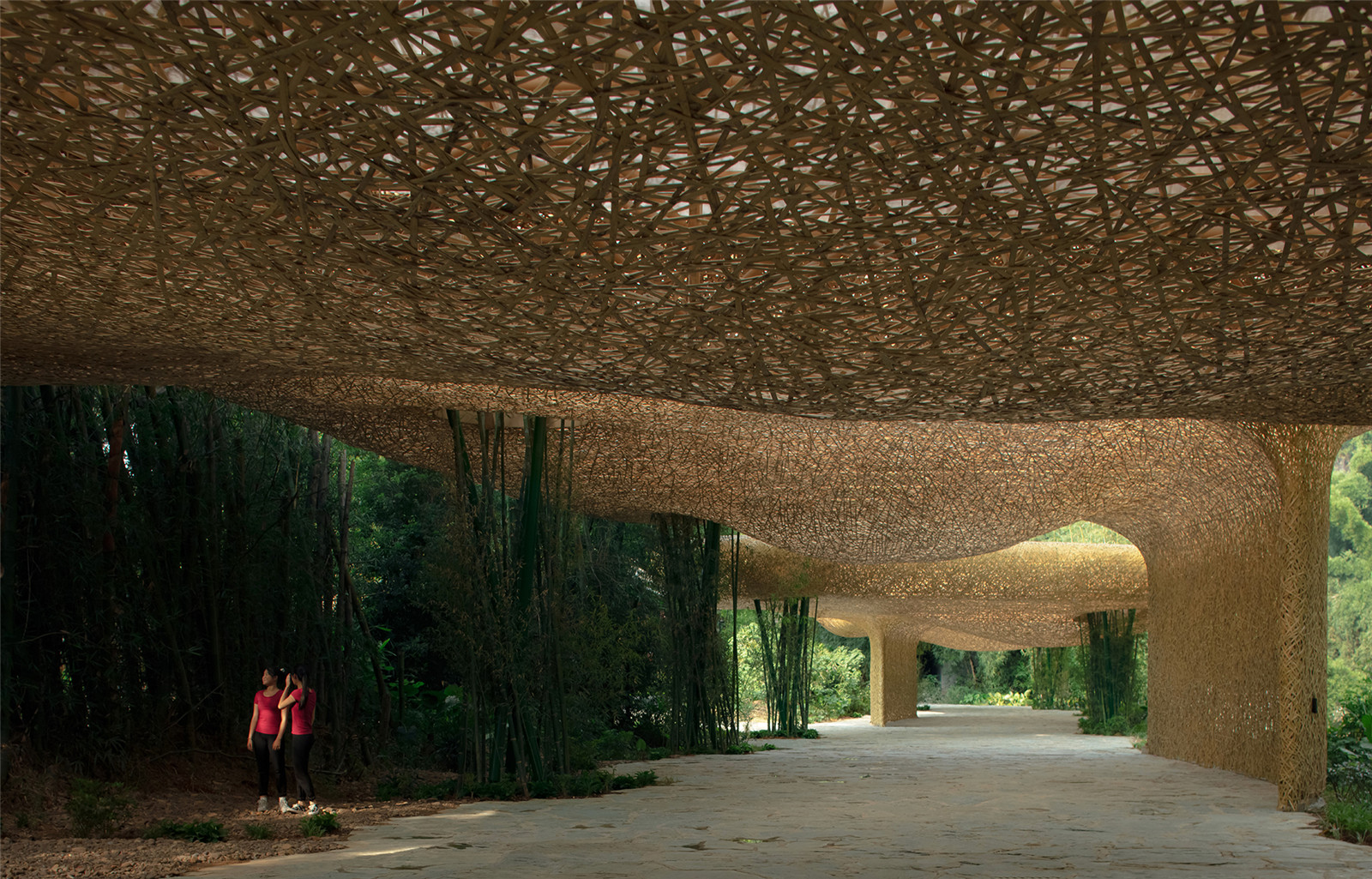
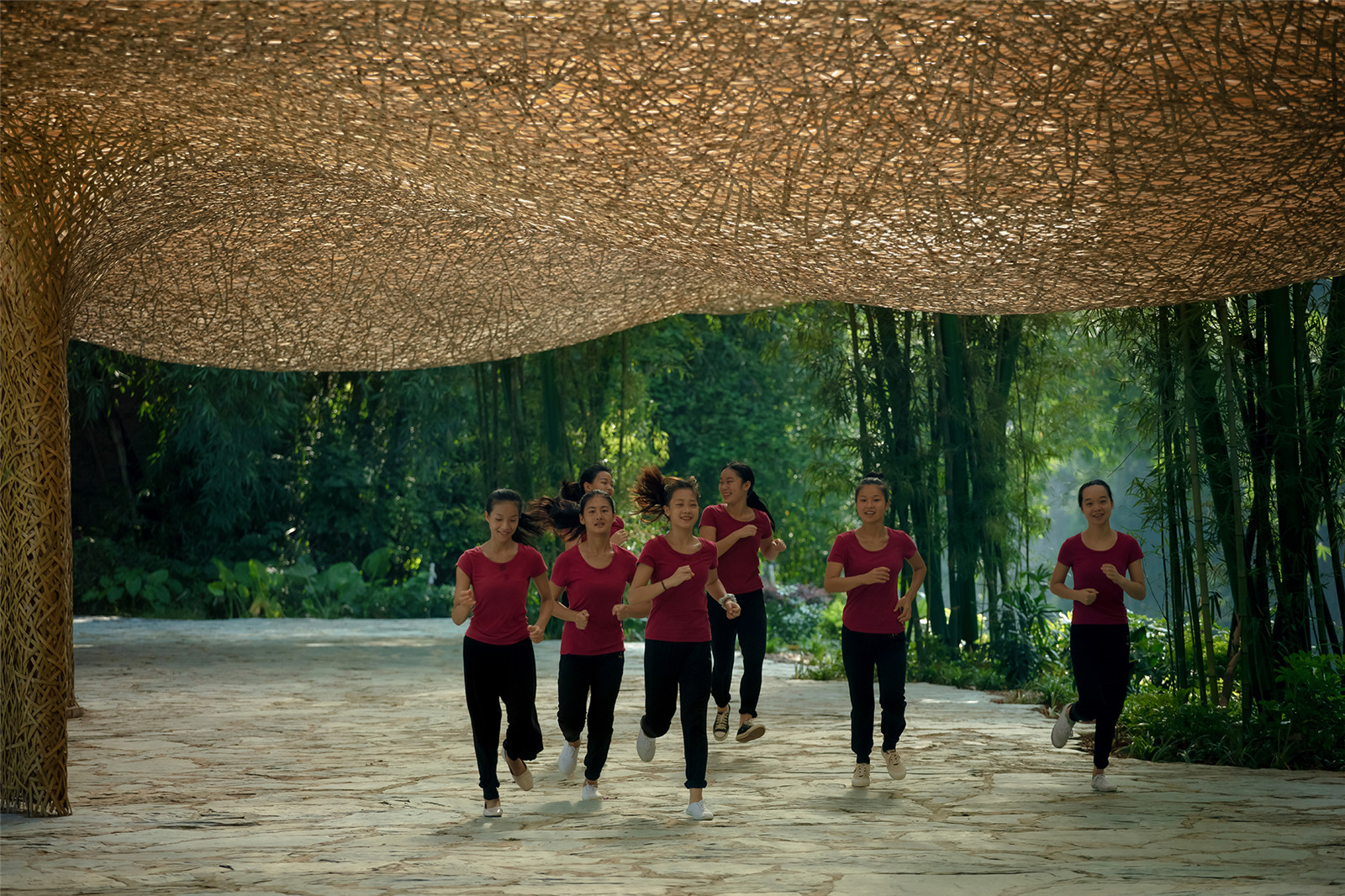
▼結(jié)構(gòu)柱隱藏在竹叢中
The structural columns hidden in the bamboos ?存在建筑
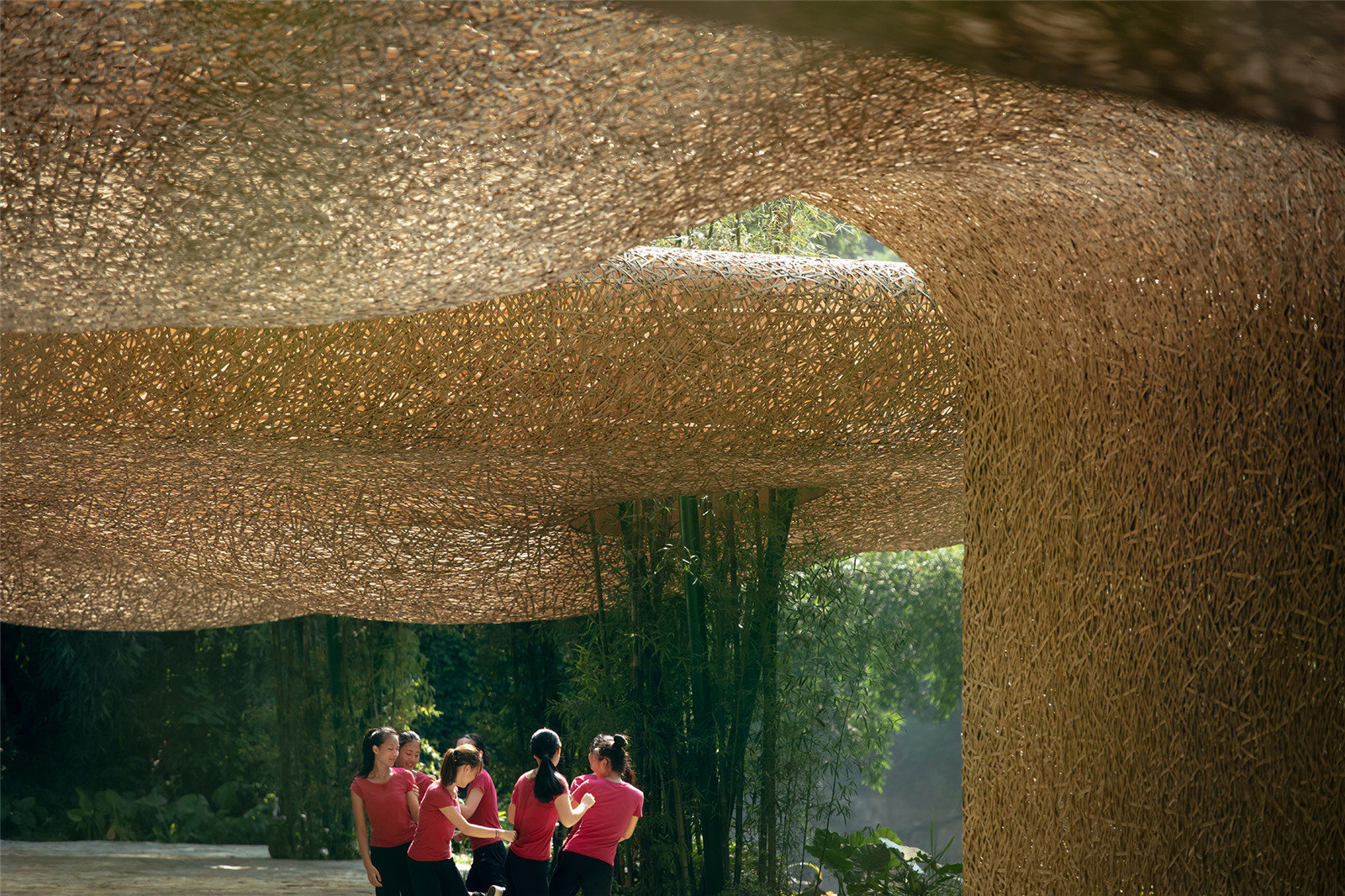
“手工竹藝長(zhǎng)廊”的竹條編織表面從入口的位置延伸140米有余���,呈倒置景觀的形狀,并不同高低幅度地上下起伏��,同時(shí)����,竹棚表面完全用與竹燈相同的不規(guī)則手工編織竹條制作而成��,看起來(lái)如是幻想中的空間體驗(yàn)�����,并順著竹體波浪飄向空間的深處���,將原本枯燥的等待體驗(yàn)變得虛幻而沉浸,又再次將訪客的感觀擴(kuò)展到整個(gè)自然環(huán)境的氛圍中去���。
Stretching 140m from where you stand the woven ceiling takes on a shape of an inverted landscape, undulating between different levels of surfaces. The stepping surface of the canopy is pieced together entirely in the same irregular hand-woven bamboo as the lantern, but on a scale that seems that it should be seated in fantasy. The resulting intention means to enchant while still extending recognition to the natural condition of the site.
▼上下起伏的竹棚
The bamboo shed up and down ?存在建筑
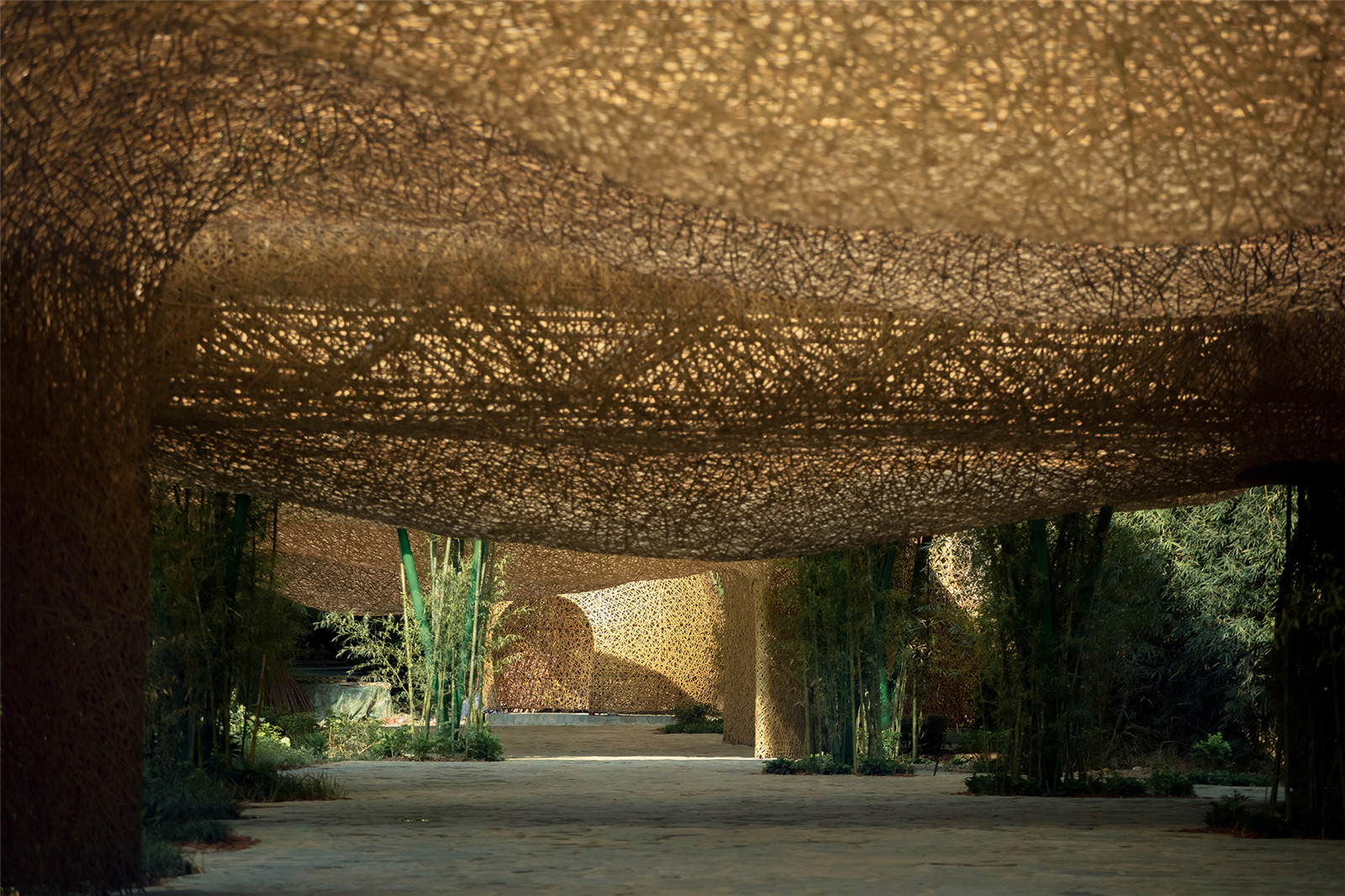

光線穿透竹編波浪���,將斑駁的光點(diǎn)散布到地面上。當(dāng)在竹棚下行走時(shí)�,光亮通過(guò)竹棚散射開(kāi)均勻的照亮整個(gè)空間,但當(dāng)抬頭仰望時(shí)���,卻可感受到意想不到的視覺(jué)體驗(yàn)���。整個(gè)頂篷散發(fā)出溫和的光芒,并發(fā)散出金色的光輝�。當(dāng)夜色降臨時(shí)�����,竹棚體內(nèi)的人造燈光光線通過(guò)竹網(wǎng)的縫隙�,將光體更有戲劇性更專(zhuān)注的照射在地面���,頂?shù)變蓪庸獠ǖ膶?shí)虛包夾���,更讓體驗(yàn)變得充實(shí)。
Under daylight, light streams through to the woven canopy bringing patches of dappled light to the ground below. While reprieve from the sun is apparent when walking underneath, in an unexpected compliment when looking up the ceiling appears illuminated, the entire canopy giving off a temperate glow. In the transition to night, introduced light within the volume rises in intensity focusing the spattering of light in a more vivid pattern on the pathway. Fragments of bodies dip in and out view as light streams down through the ceiling above onto guests making their way the stage.
▼日光下的長(zhǎng)廊
Canopy under the sunlight ?存在建筑

▼竹棚頂篷散發(fā)出溫和的光芒
The entire canopy giving off a temperate glow ?存在建筑
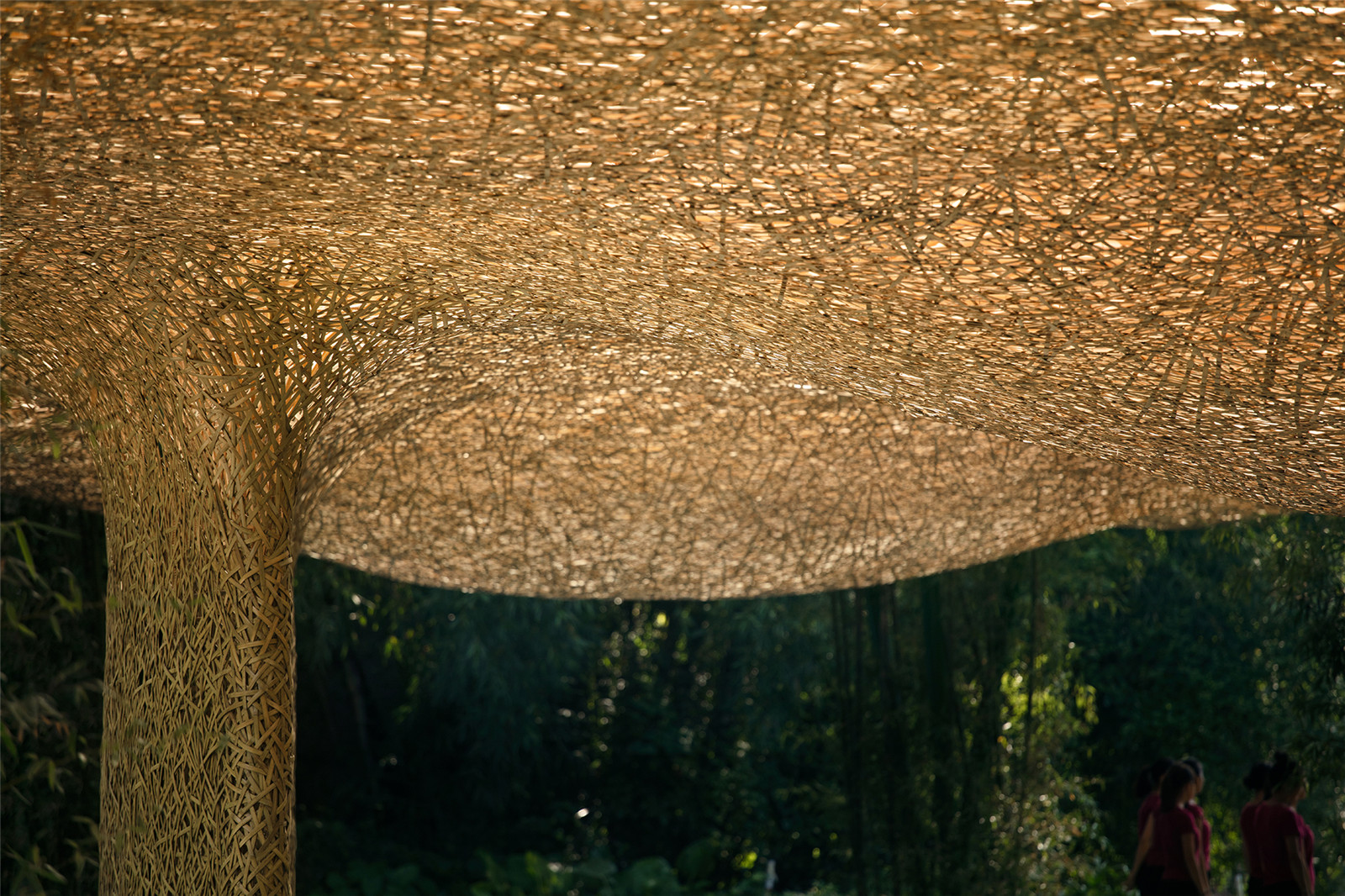
對(duì)劉三姐印象的戲劇精神的認(rèn)可及對(duì)當(dāng)?shù)刈匀画h(huán)境的感動(dòng)和尊敬�����,很多感知的元素潛移默化地穿插進(jìn)入了設(shè)計(jì)的許多部分:手工編織文化的融入��,竹條材料的使用與自然竹林環(huán)境的融合�,竹棚起伏的倒置地形在竹叢立柱之間的舞動(dòng),結(jié)構(gòu)柱的體態(tài)與竹子生長(zhǎng)形態(tài)的呼應(yīng)�����,甚至在敘事性的流線及互動(dòng)情境中�����,訪客從一個(gè)竹燈移到另一個(gè)空間的方式����,這些微妙的細(xì)節(jié)提示共同激發(fā)了特定的意識(shí)感知框架,為訪客觀看印象劉三姐的演出帶來(lái)了最好的心理和文化的鋪墊��。
In acknowledgment to the theatrical spirit of the Impression Sanjie Liu, moments of performance make its way into many parts of the design: The hand weaving, bamboo playing off the tension of one another. The topography of the canopy ceiling dancing between columns of bamboo as if unsupported. Even the way guests are intended to move from lantern to lantern, in a narrative of interaction. Together these subtle hints encourage a particular frame of mind, readying the guest for the main feature.
▼編織文化�����、竹條材料與自然環(huán)境的融合
Integration of weaving culture, bamboo strip material and natural environment ?存在建筑
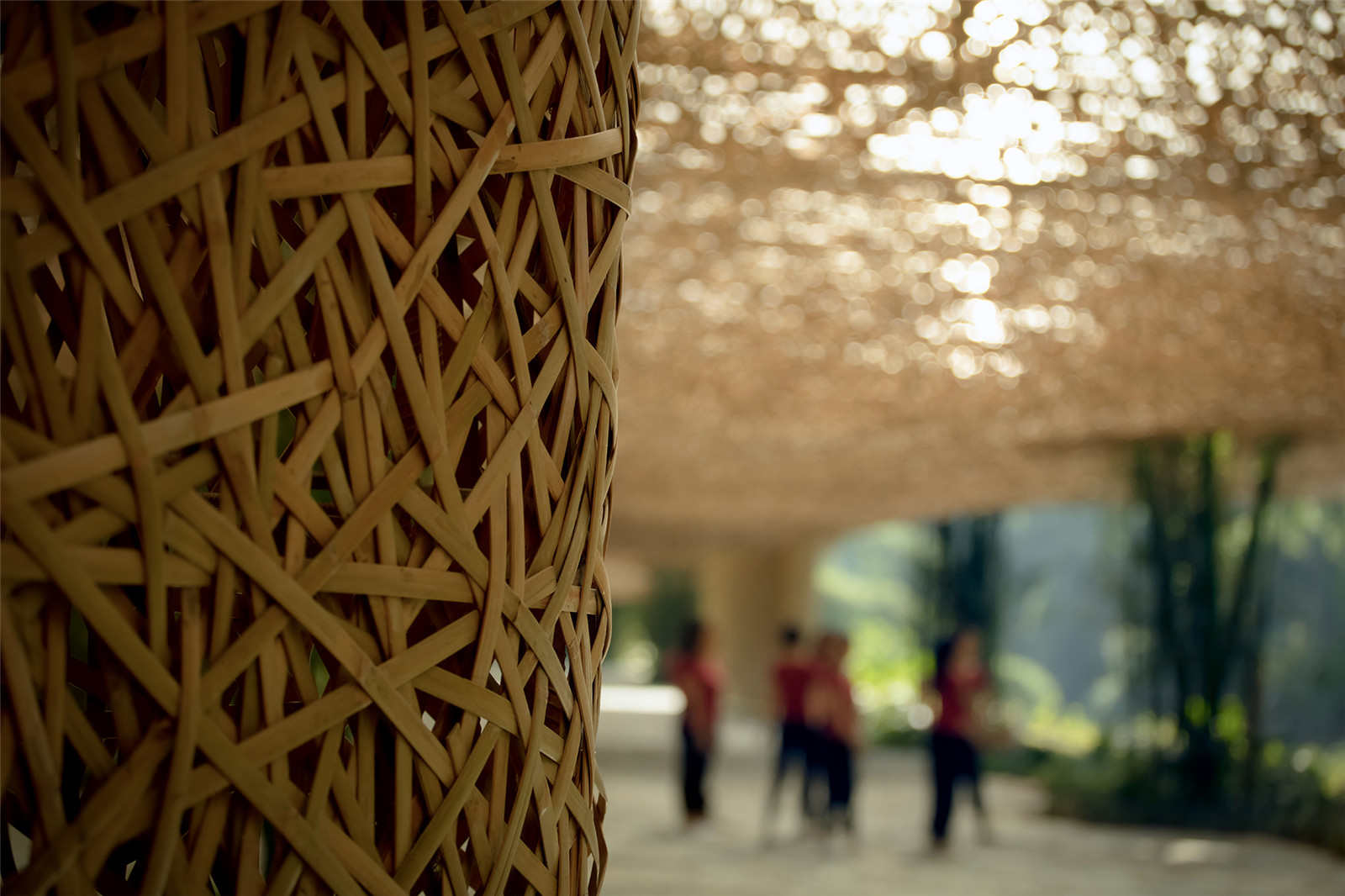
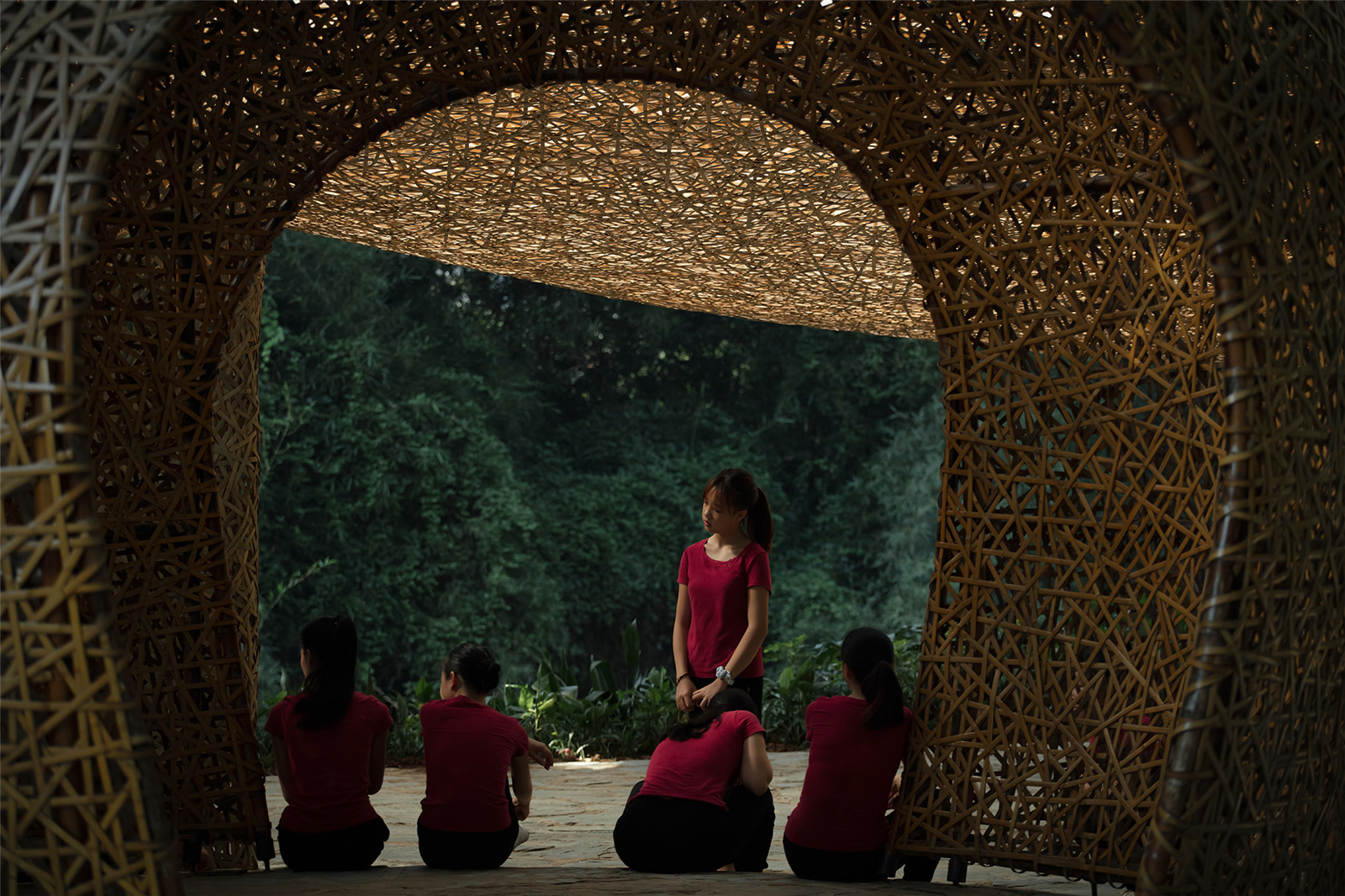
▼模型圖
Physical model ?llLab. 敘向建筑設(shè)計(jì)

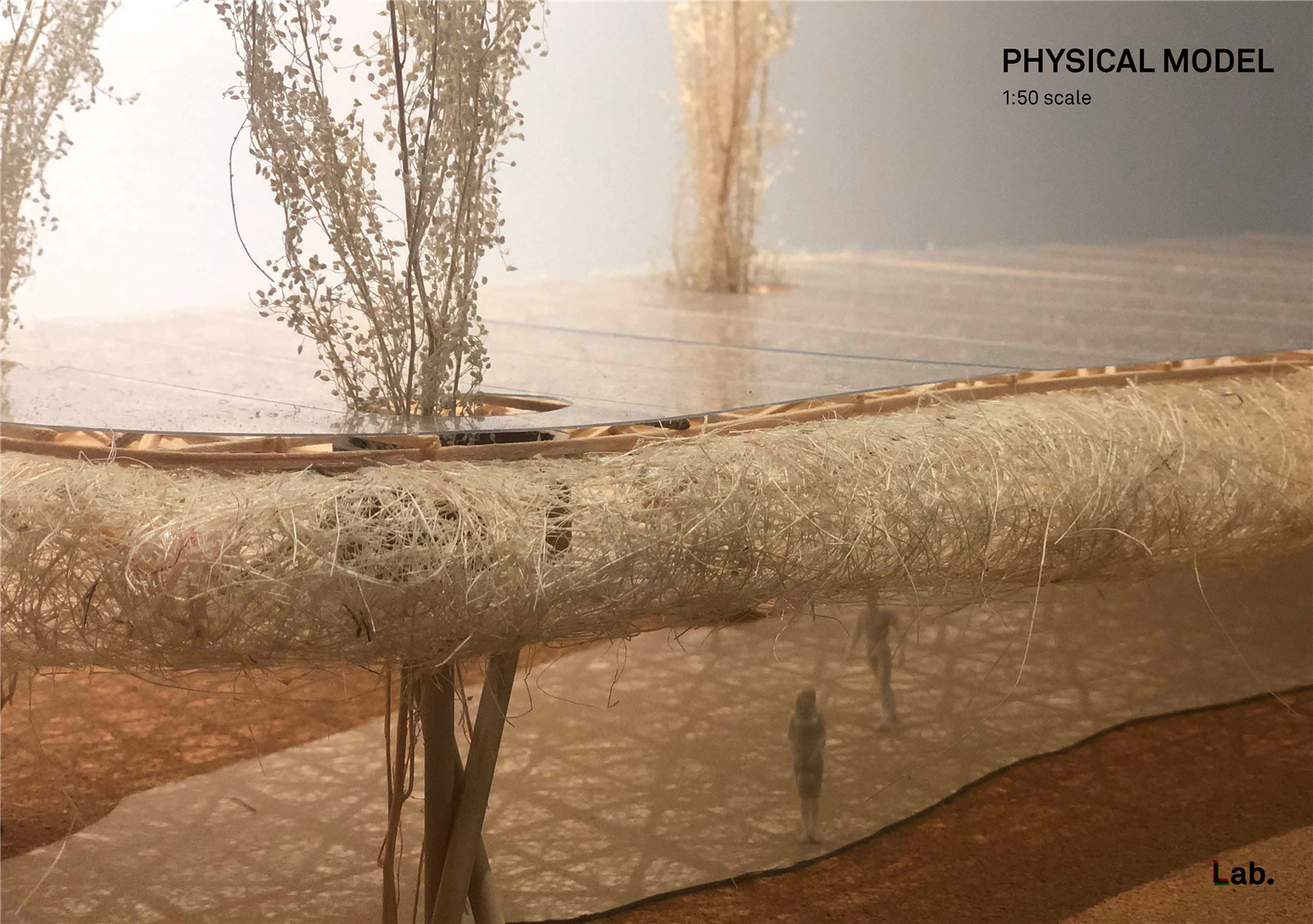
項(xiàng)目信息
項(xiàng)目名稱(chēng):竹林亭臺(tái)樓閣(印象劉三姐園區(qū))
項(xiàng)目地點(diǎn):中國(guó)桂林陽(yáng)朔
場(chǎng)地面積:90000m2
建筑面積:1900m2
項(xiàng)目狀態(tài):已完工
項(xiàng)目時(shí)間:2018年5月-2020年7月
項(xiàng)目客戶:桂林大型山水實(shí)景演出《印象?劉三姐》
建筑設(shè)計(jì)公司:llLab. | 敘向建筑設(shè)計(jì)(https://www.lllab.net/)
建筑設(shè)計(jì):劉涵曉���、Henry D'Ath�、胡樂(lè)賢�、Alyssa Tang、范超然���、Luis Ricardo��、David Correa
項(xiàng)目管理總承包:玻陶鉑絲(上海)建設(shè)工程有限公司
項(xiàng)目管理:密李華�、柴大林��、張浩�����、萬(wàn)國(guó)陽(yáng)
結(jié)構(gòu)設(shè)計(jì):欒櫨構(gòu)造設(shè)計(jì)事務(wù)所
竹燈、竹編���、結(jié)構(gòu)前期研發(fā):上海檀檀道具有限公司
研發(fā)團(tuán)隊(duì):崔齊明�、孟庚
竹燈�、竹編施工,結(jié)構(gòu)安裝:上海境道原竹建筑設(shè)計(jì)工程有限公司
原石地面:劉海明��、劉靜���、蔡長(zhǎng)發(fā)��、余和權(quán)��、梁火鳳�、余和坤��、余代中�、陶秀平、李保興���、安若缺
攝影:存在建筑-建筑攝影
版權(quán)聲明:本文版權(quán)歸原作者所有���,請(qǐng)勿以景觀中國(guó)編輯版本轉(zhuǎn)載。如有侵犯您的權(quán)益請(qǐng)及時(shí)聯(lián)系�����,我們將第一時(shí)間刪除��。
投稿郵箱:info@landscape.cn
項(xiàng)目咨詢:18510568018(微信同號(hào))
 京公海網(wǎng)安備 110108000058號(hào)
京公海網(wǎng)安備 110108000058號(hào)




































